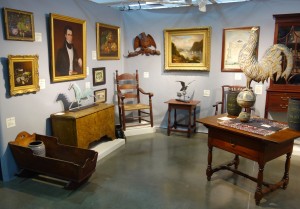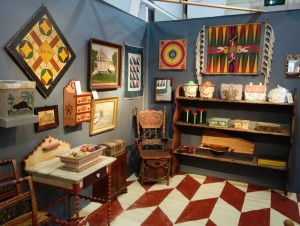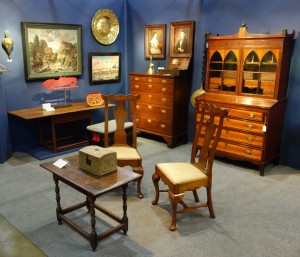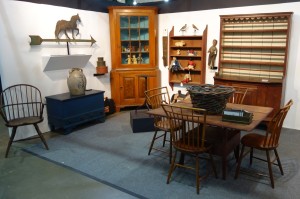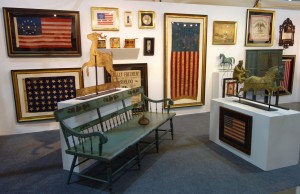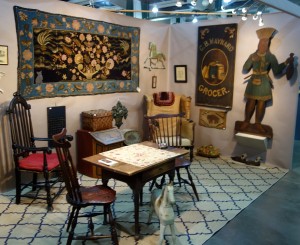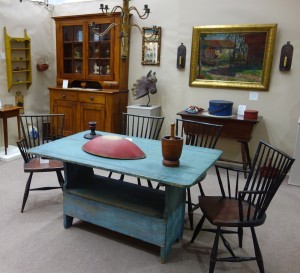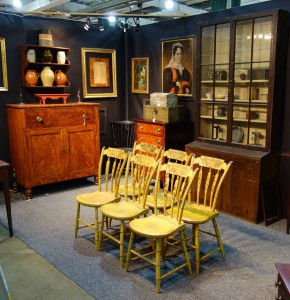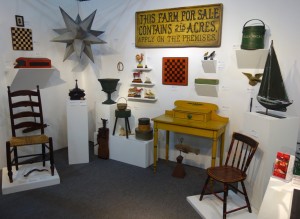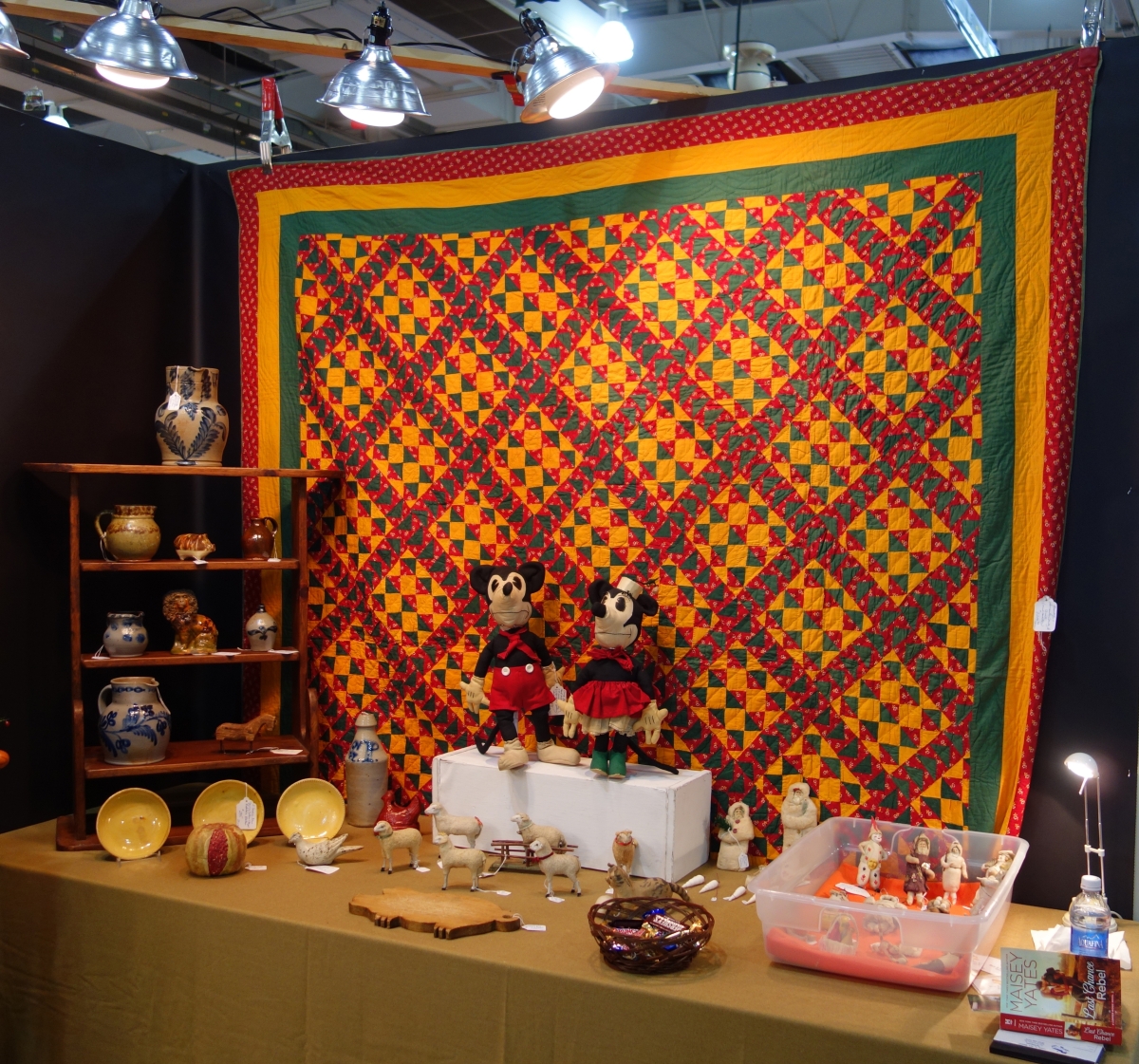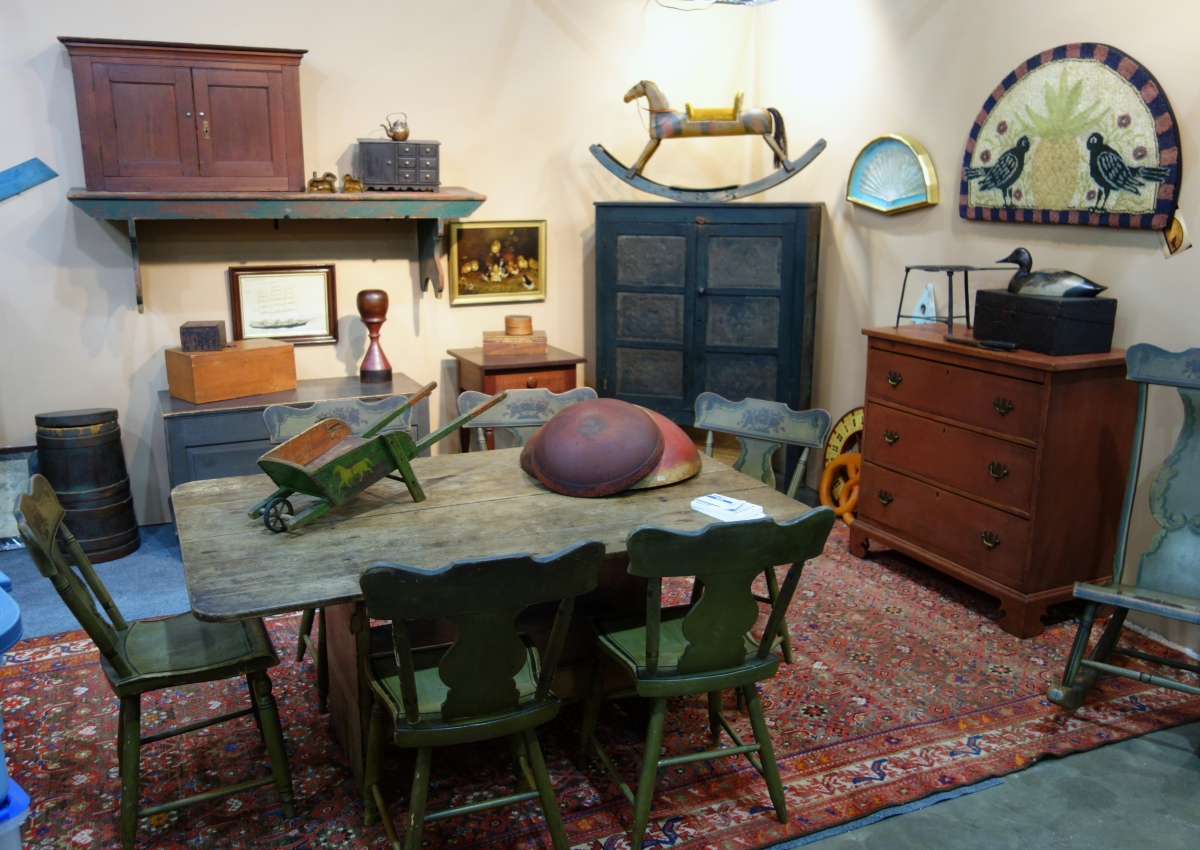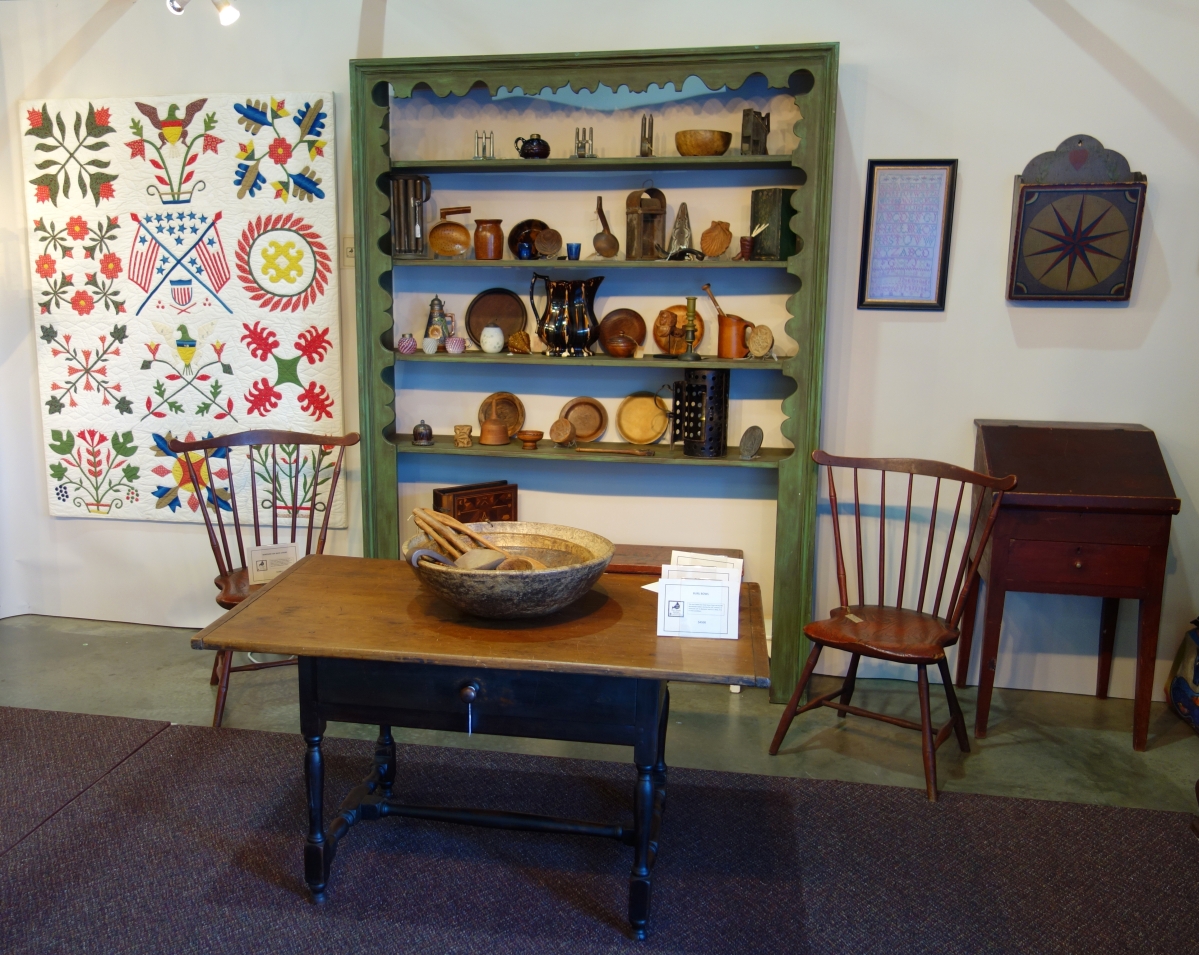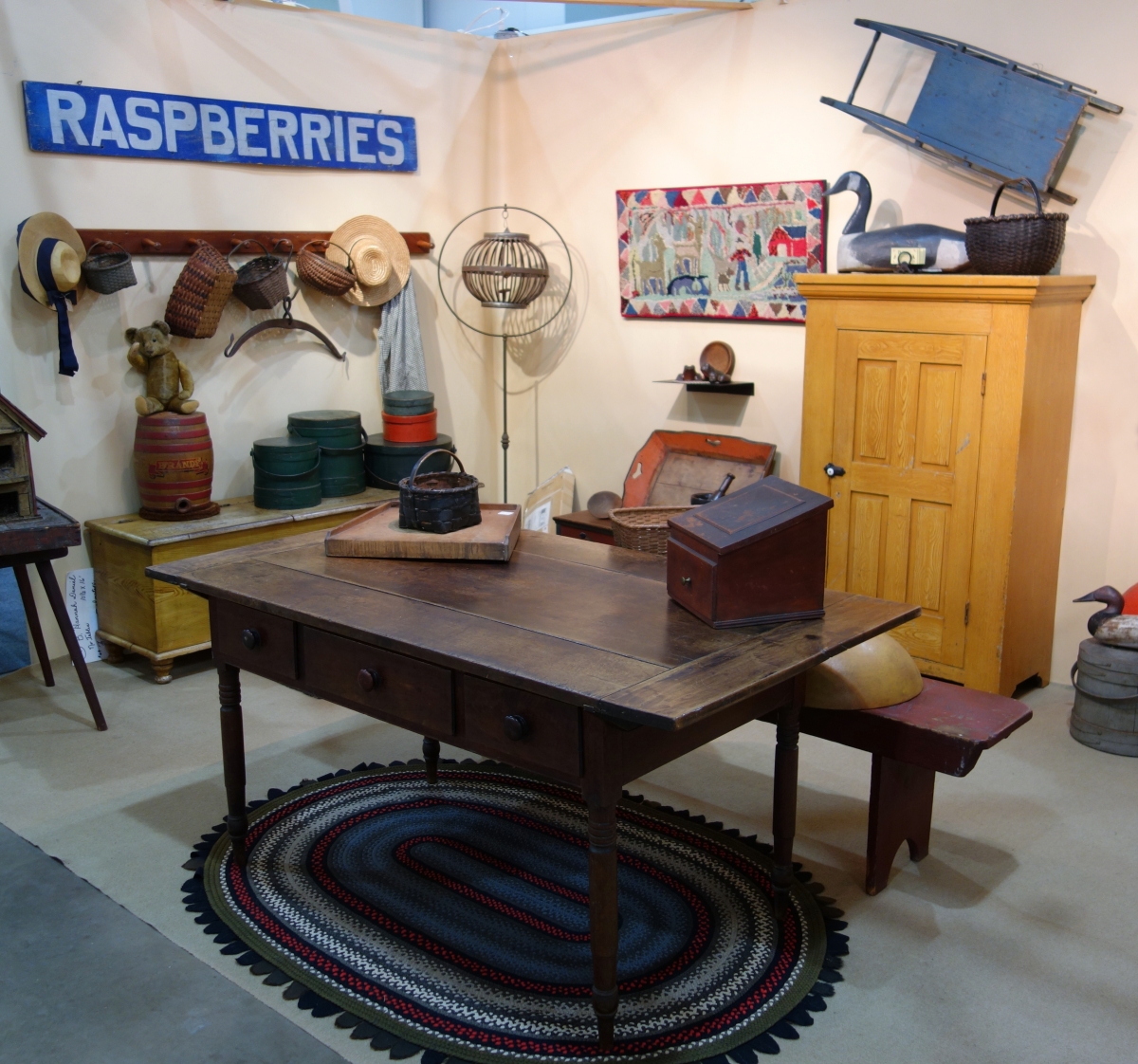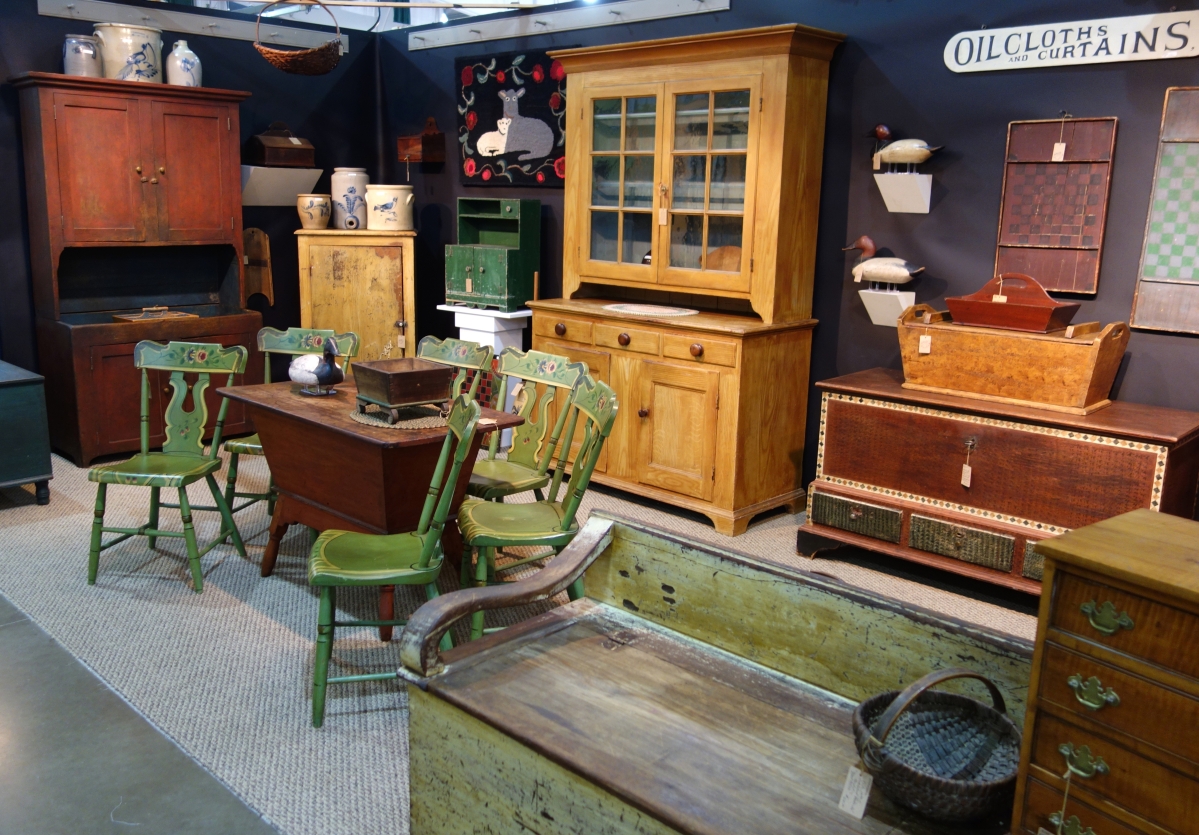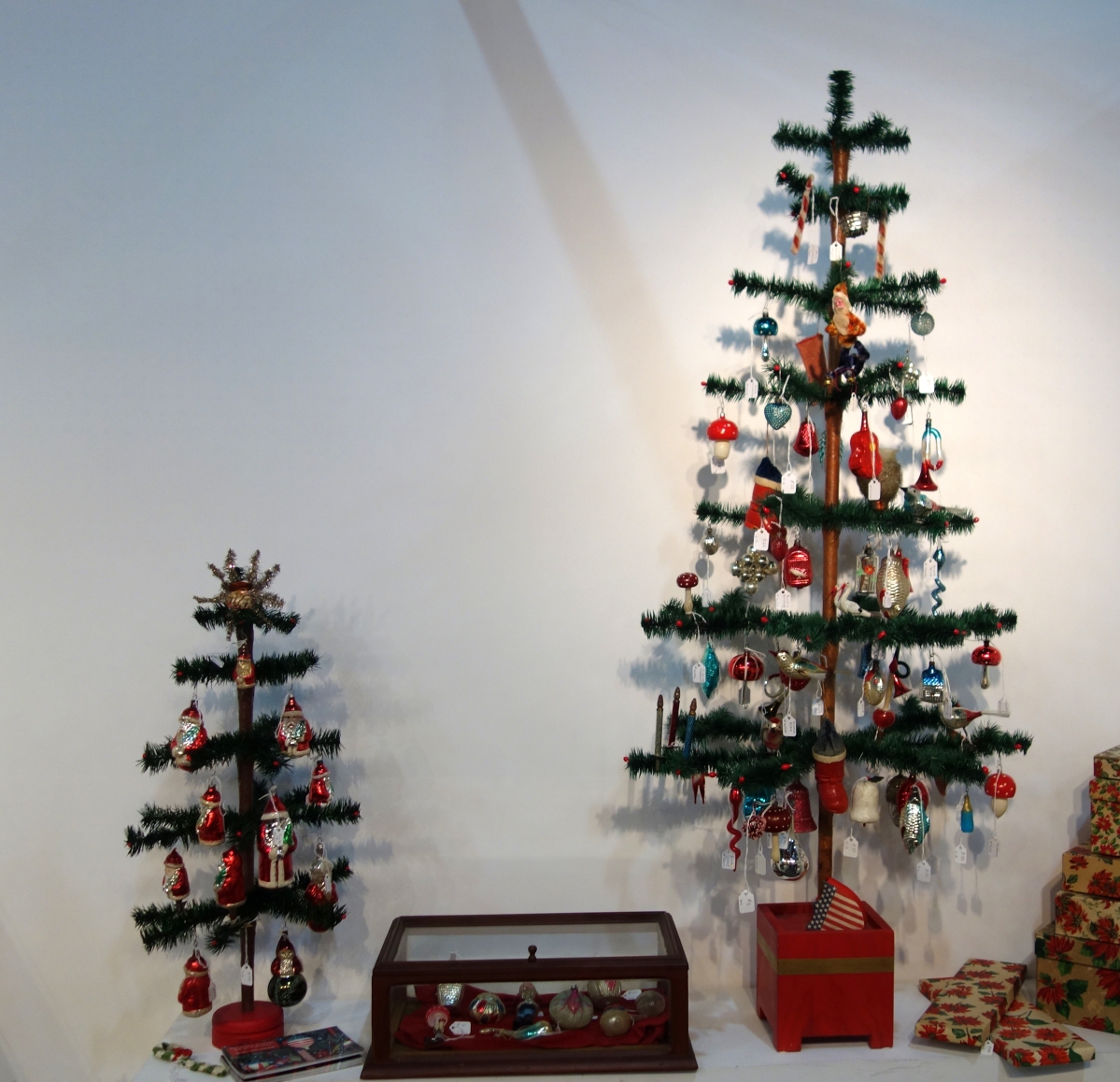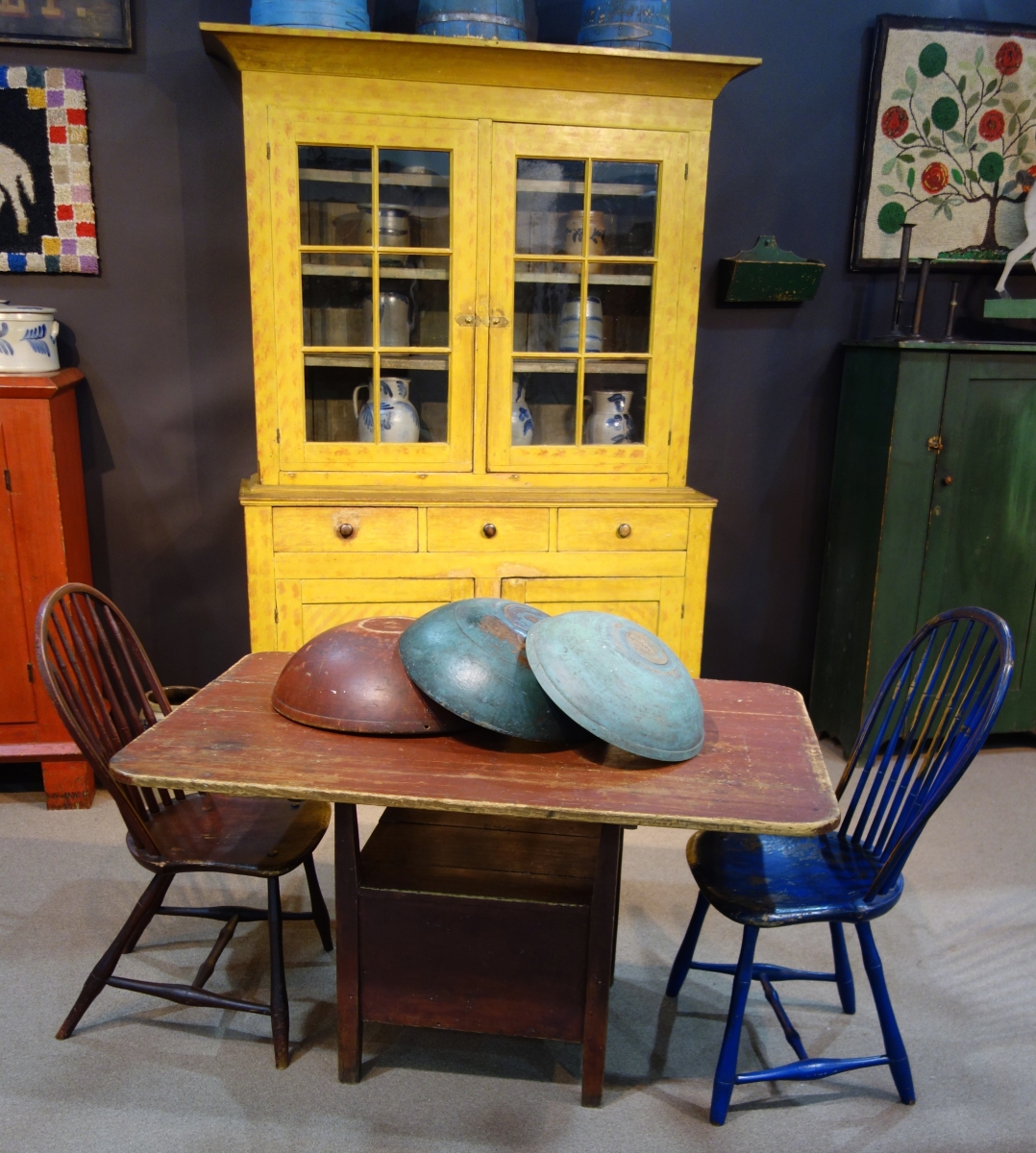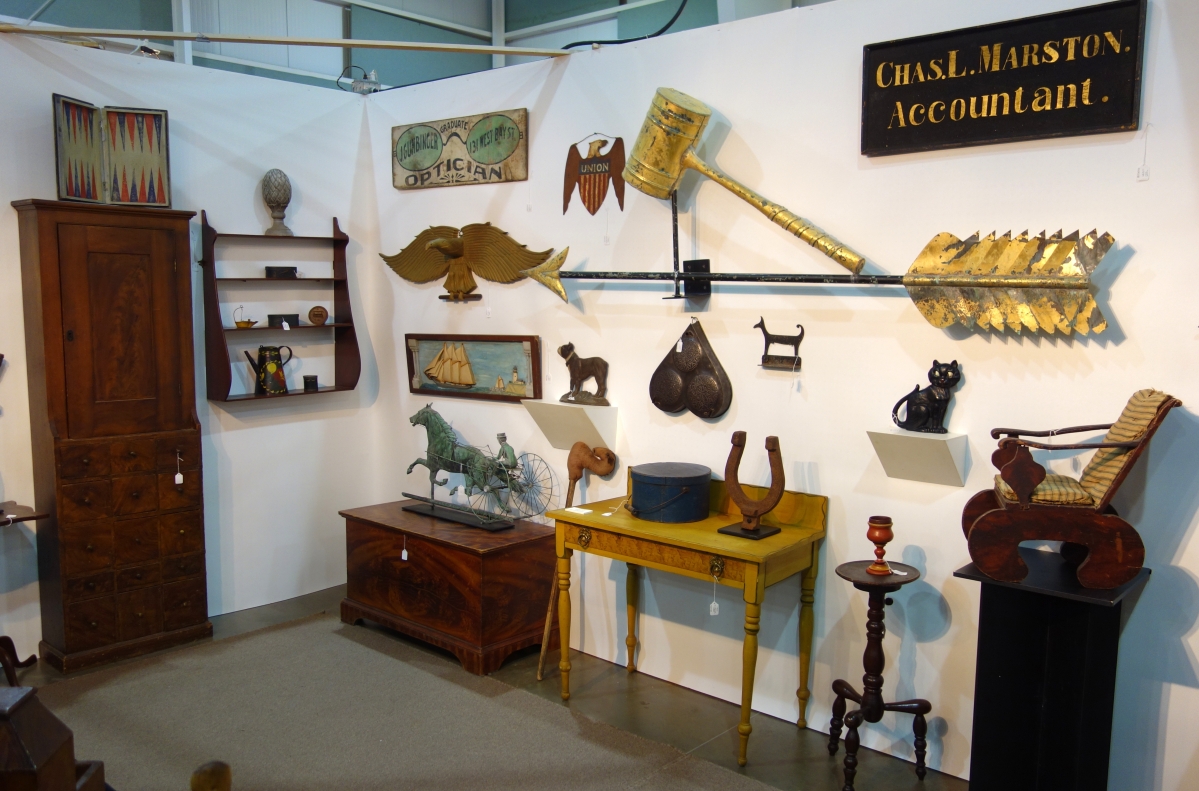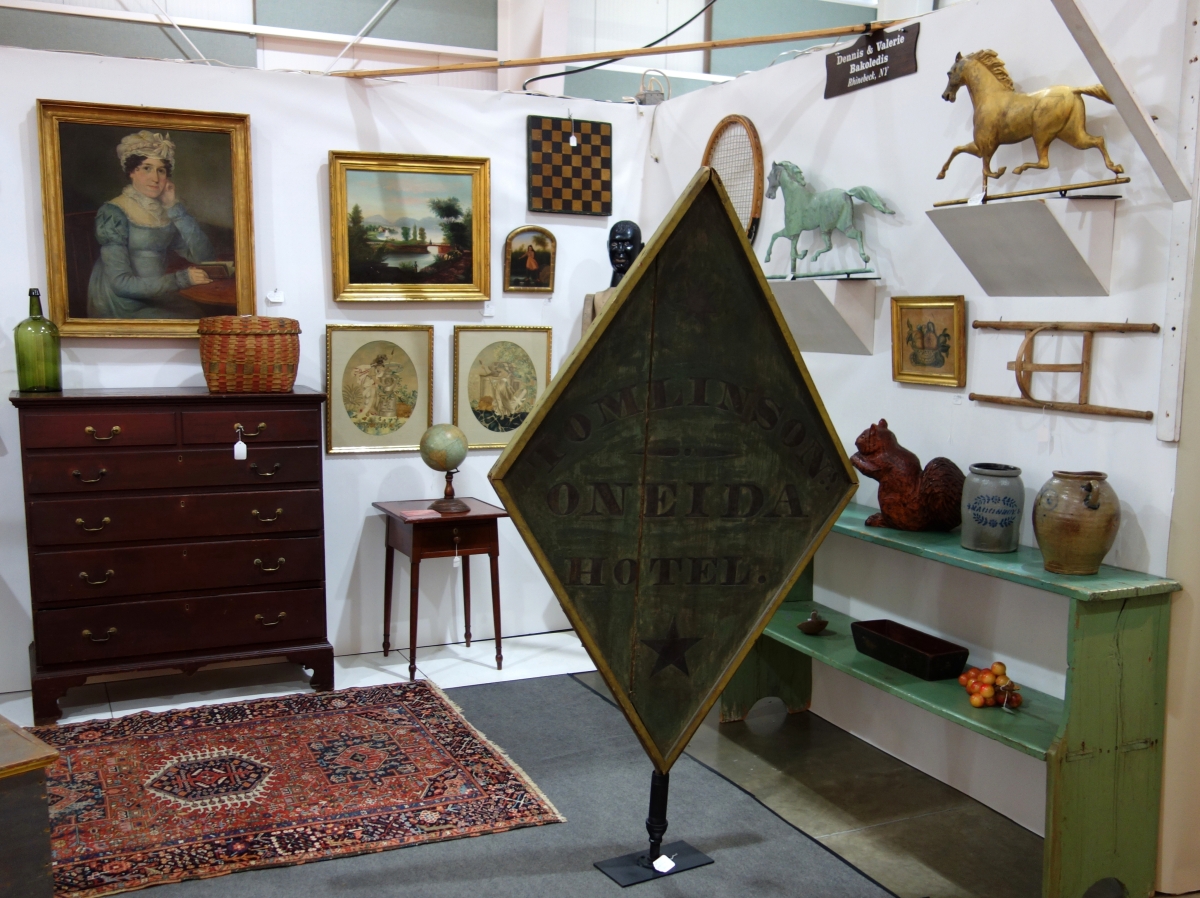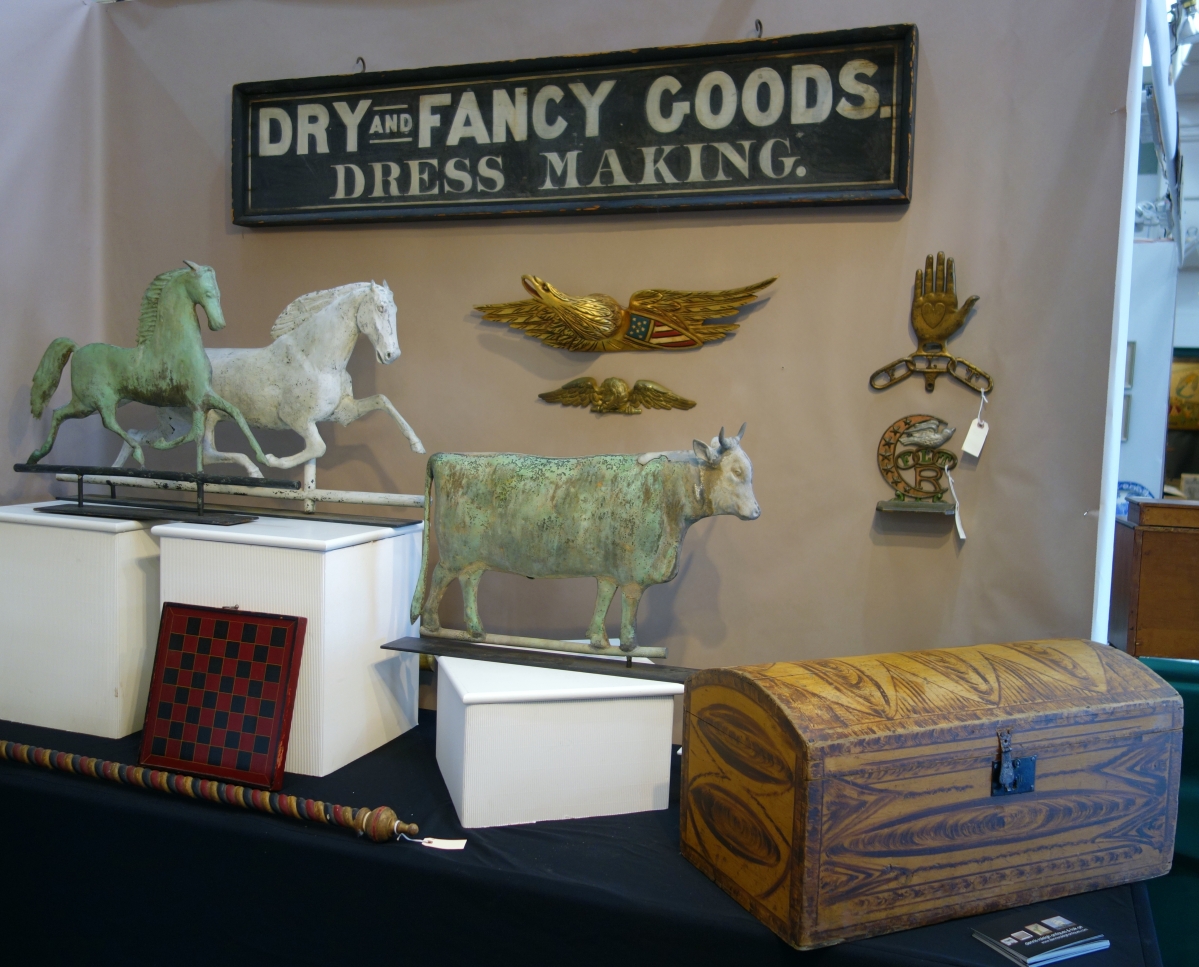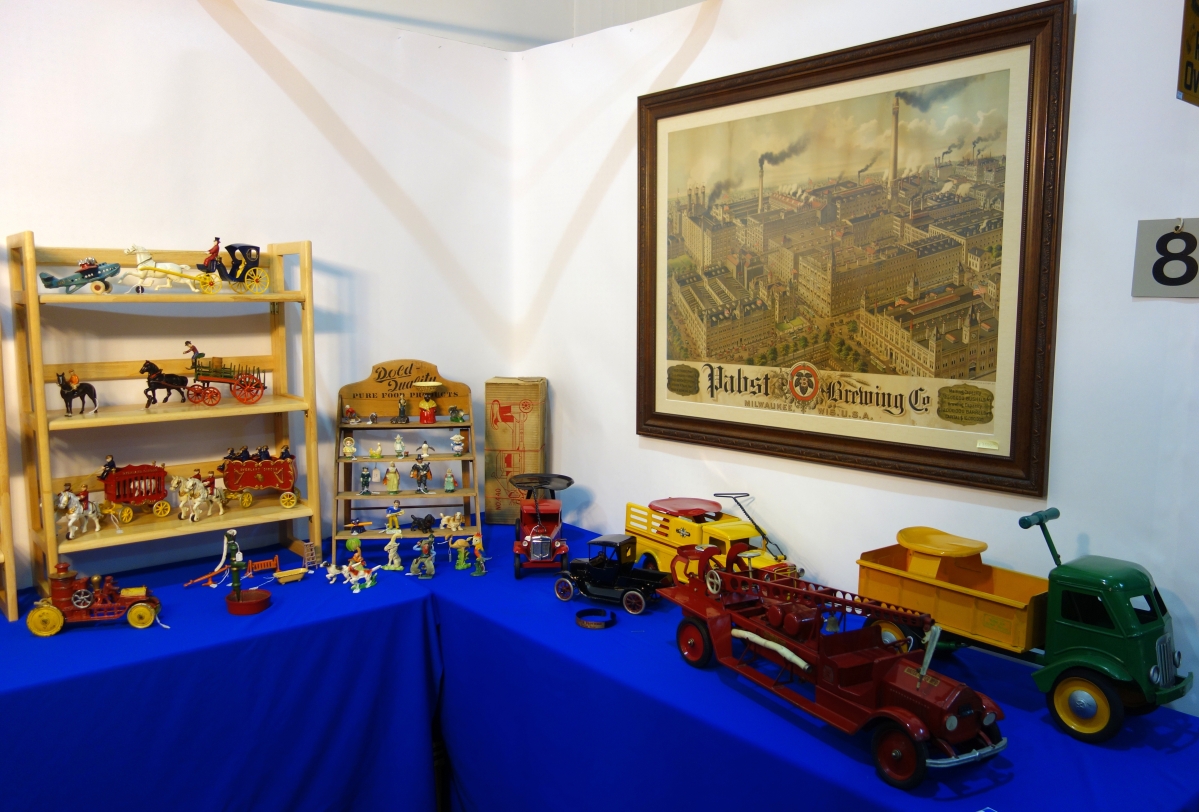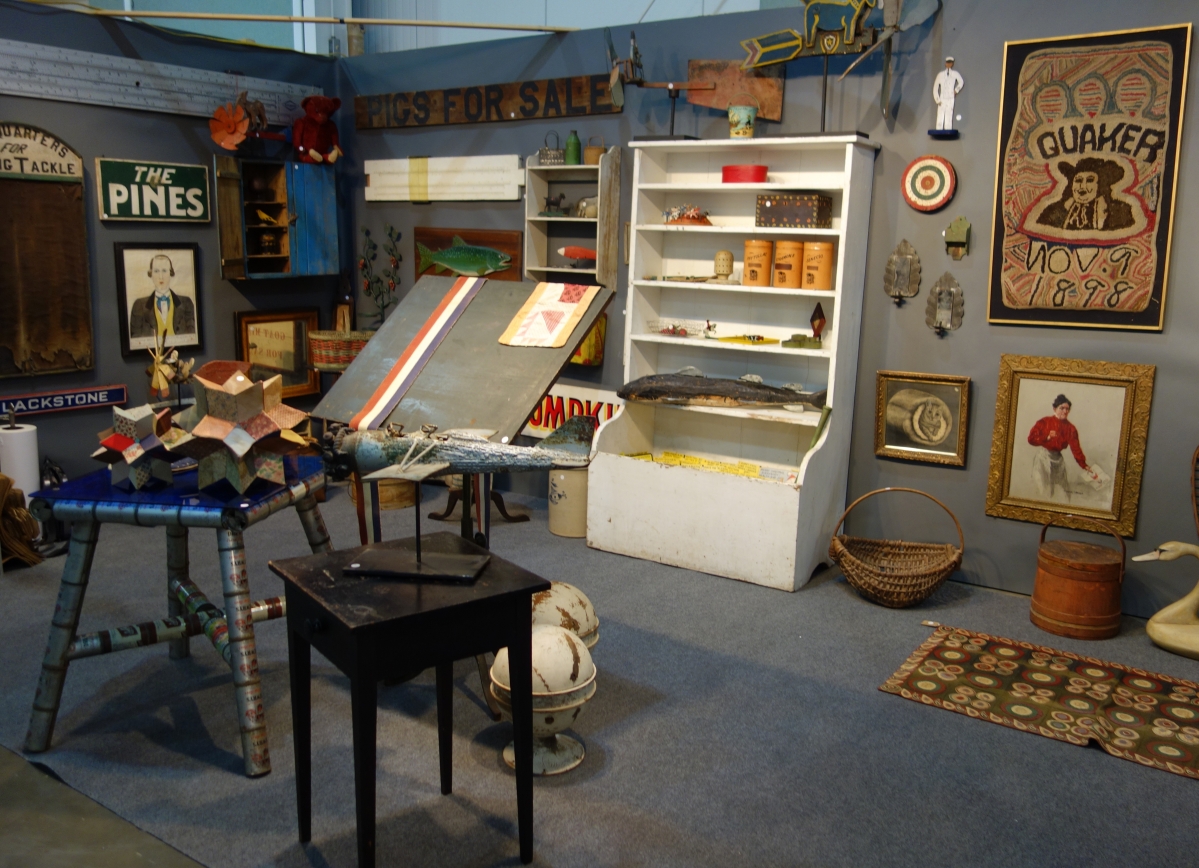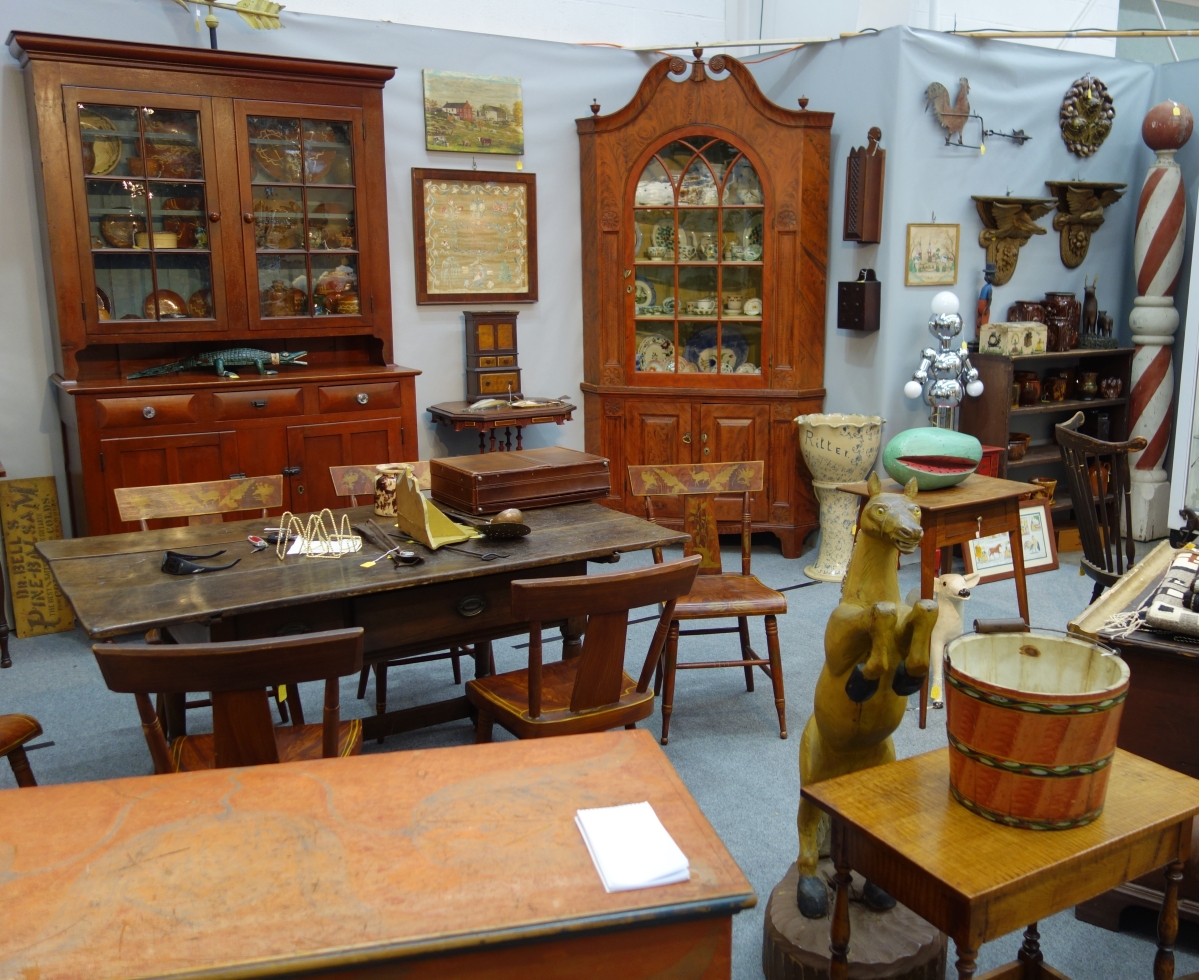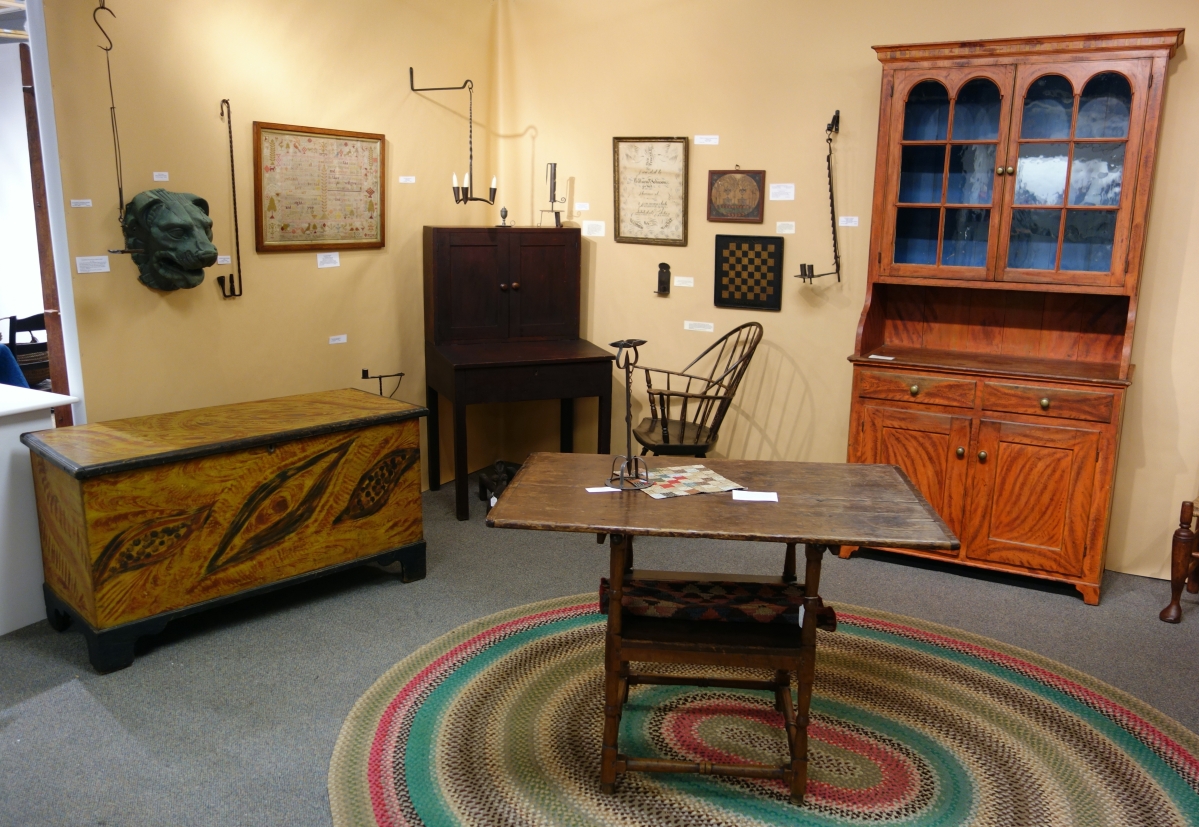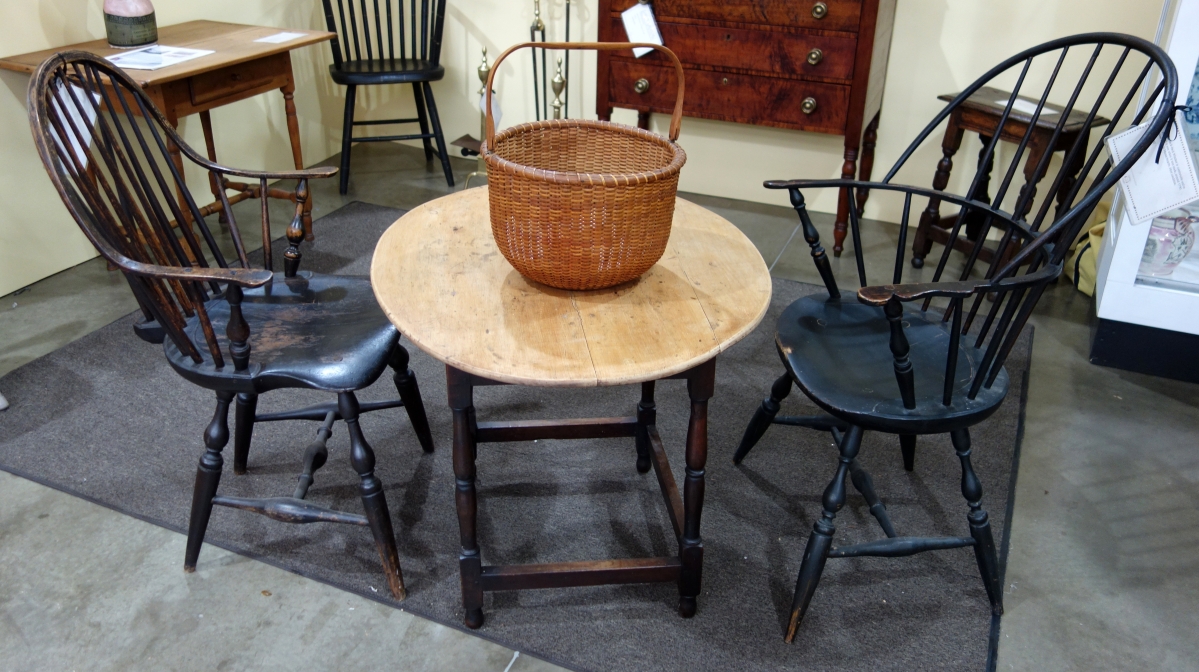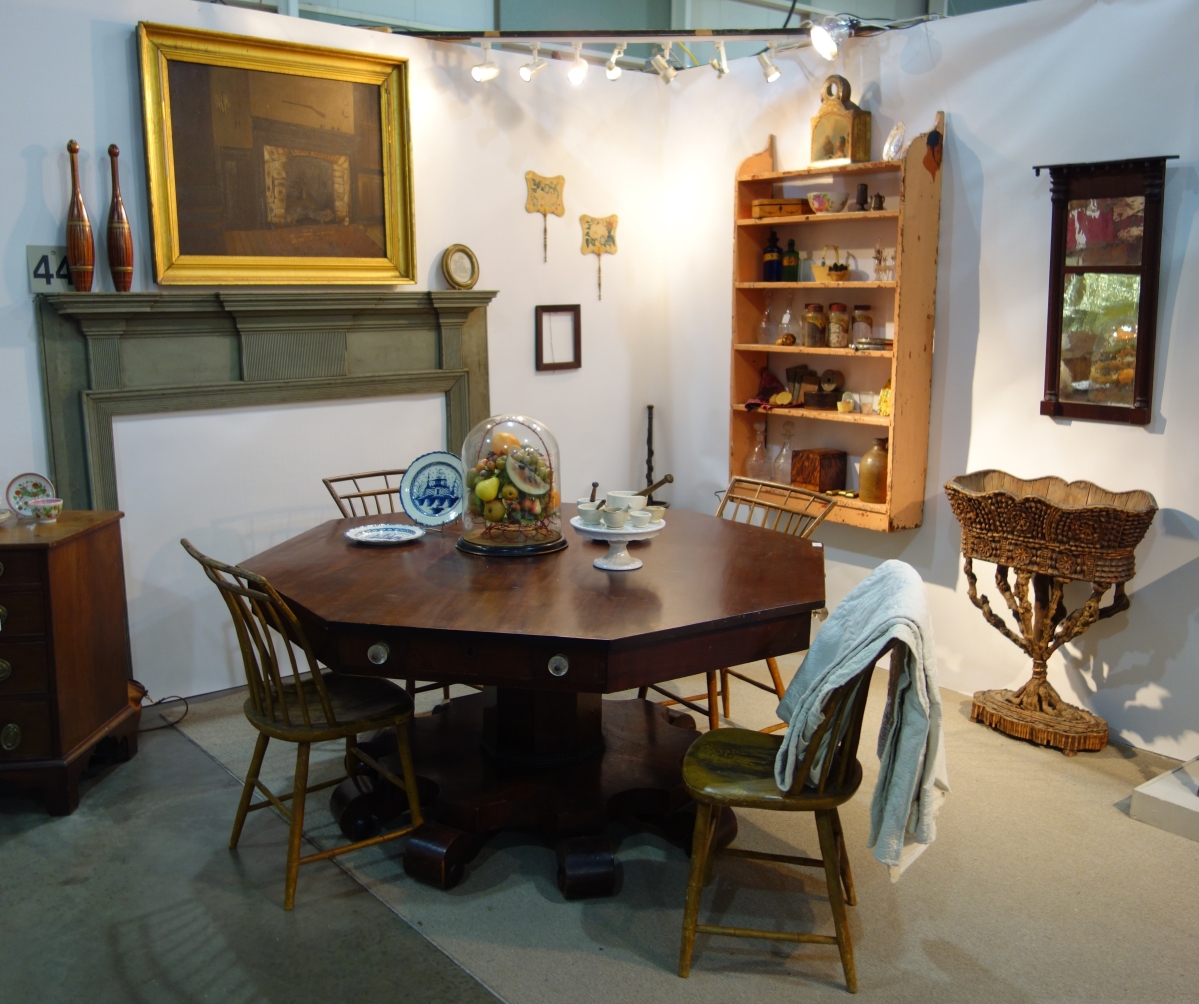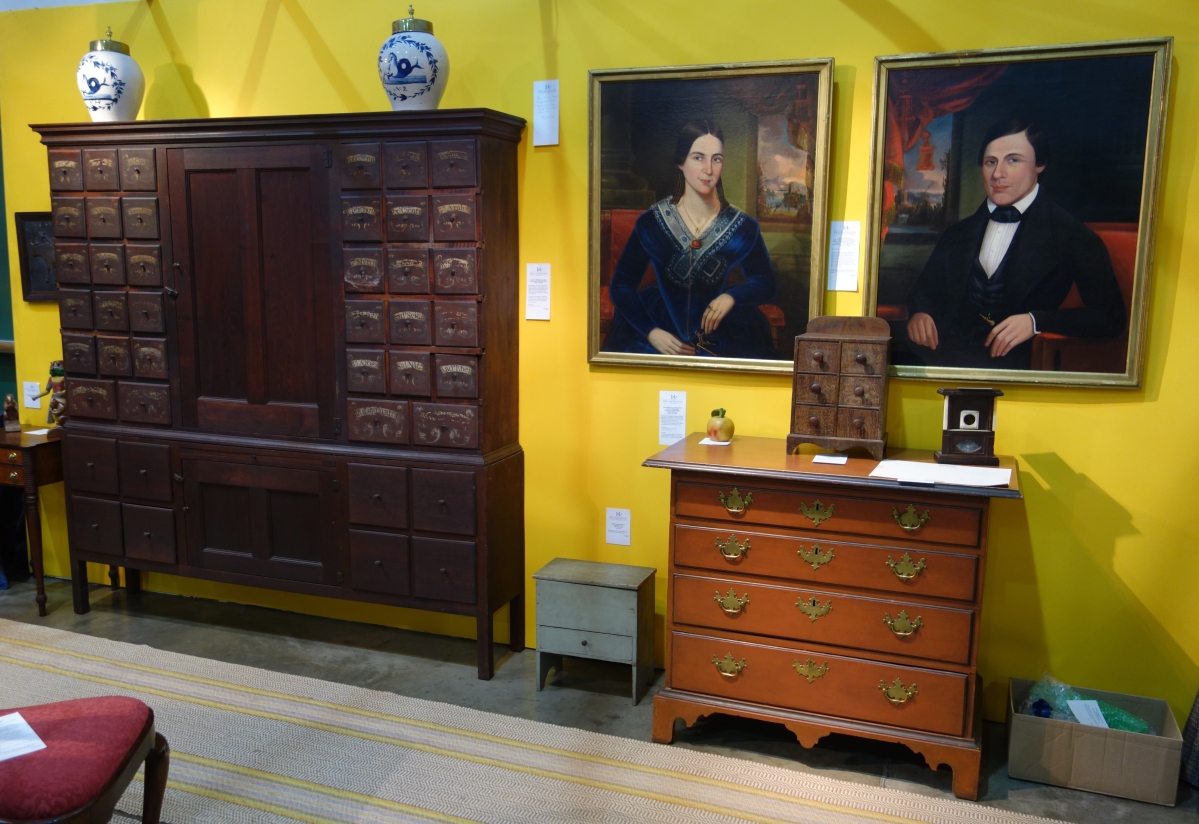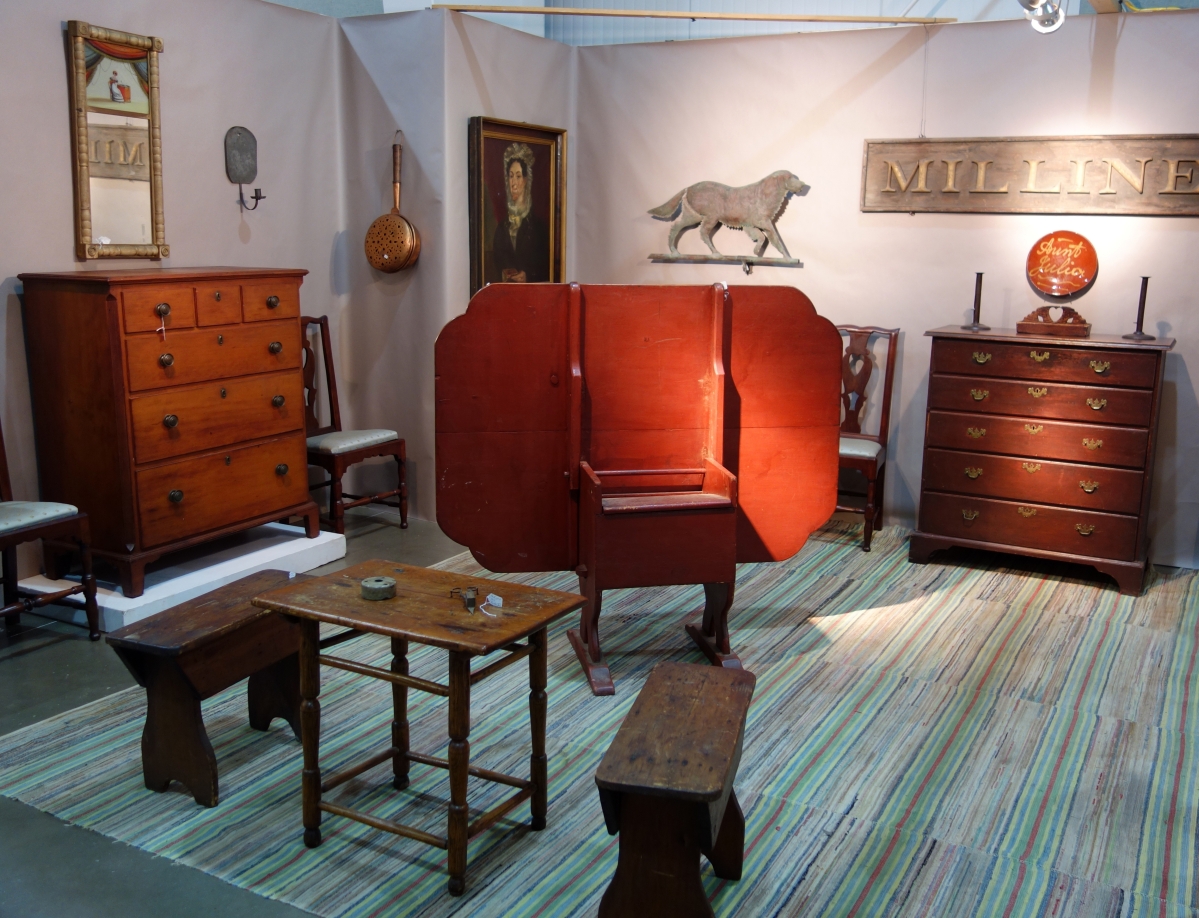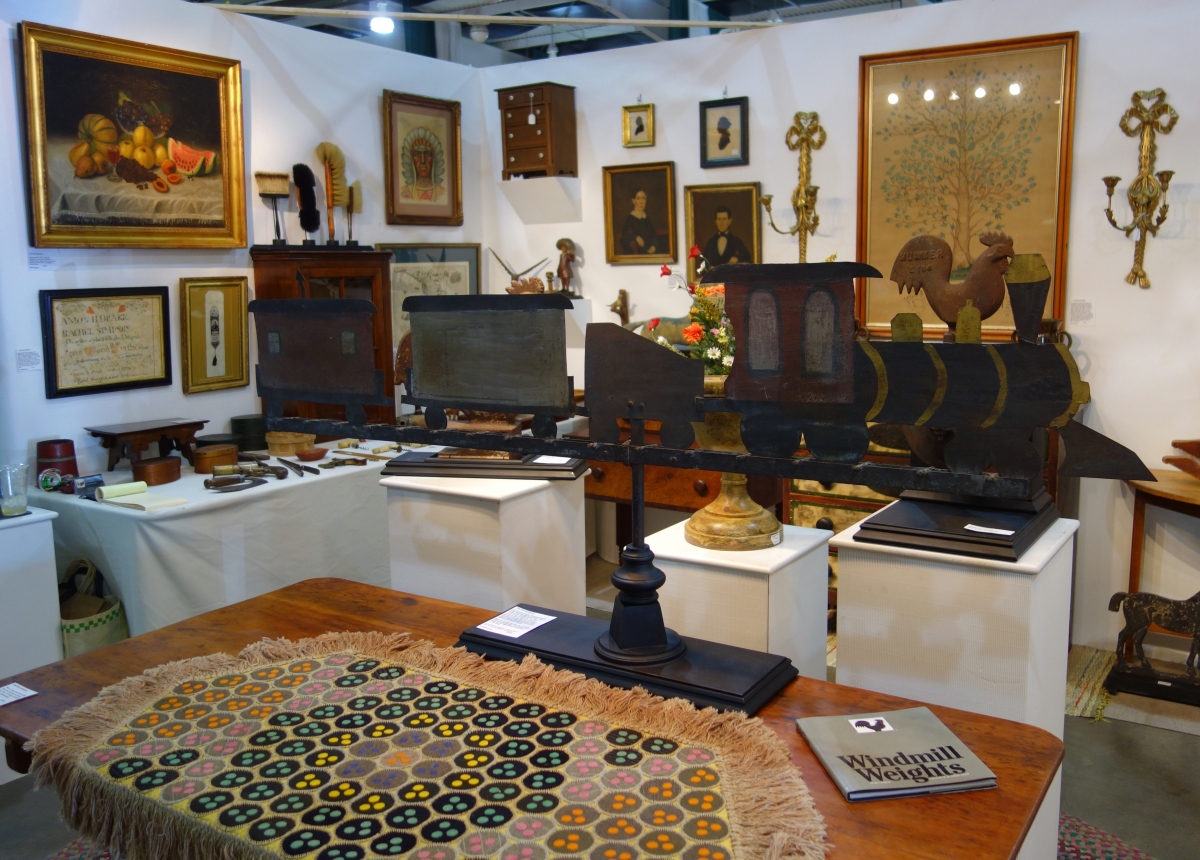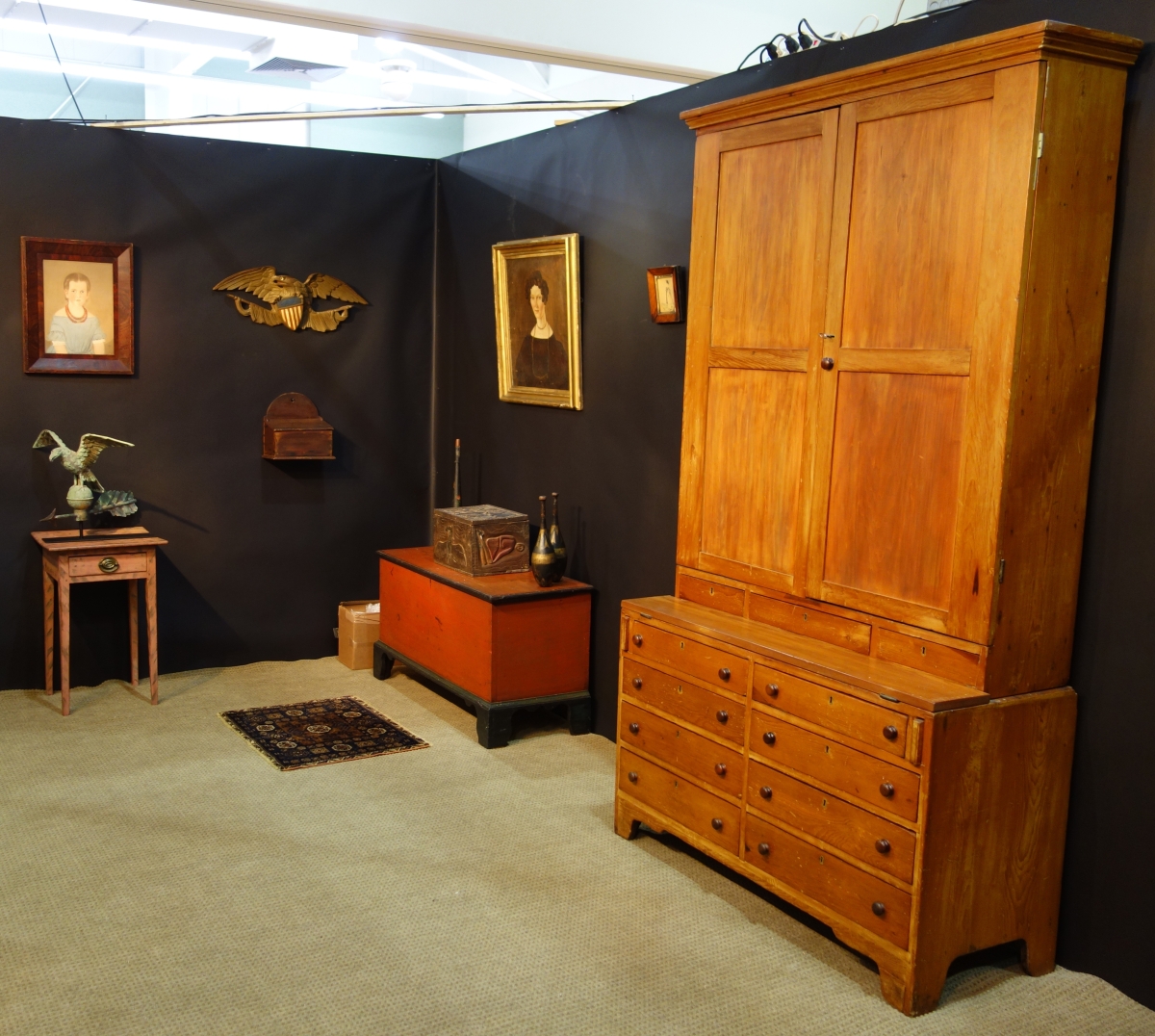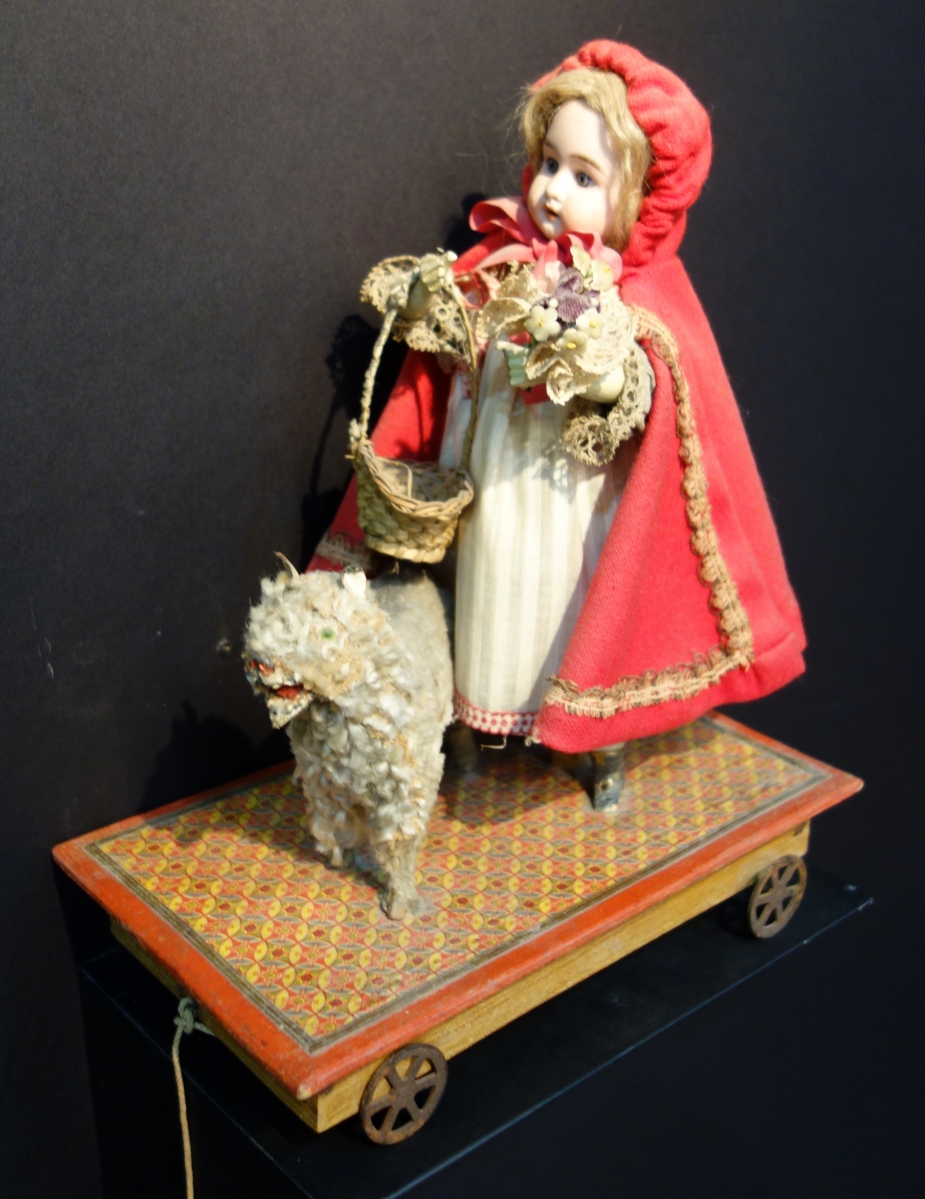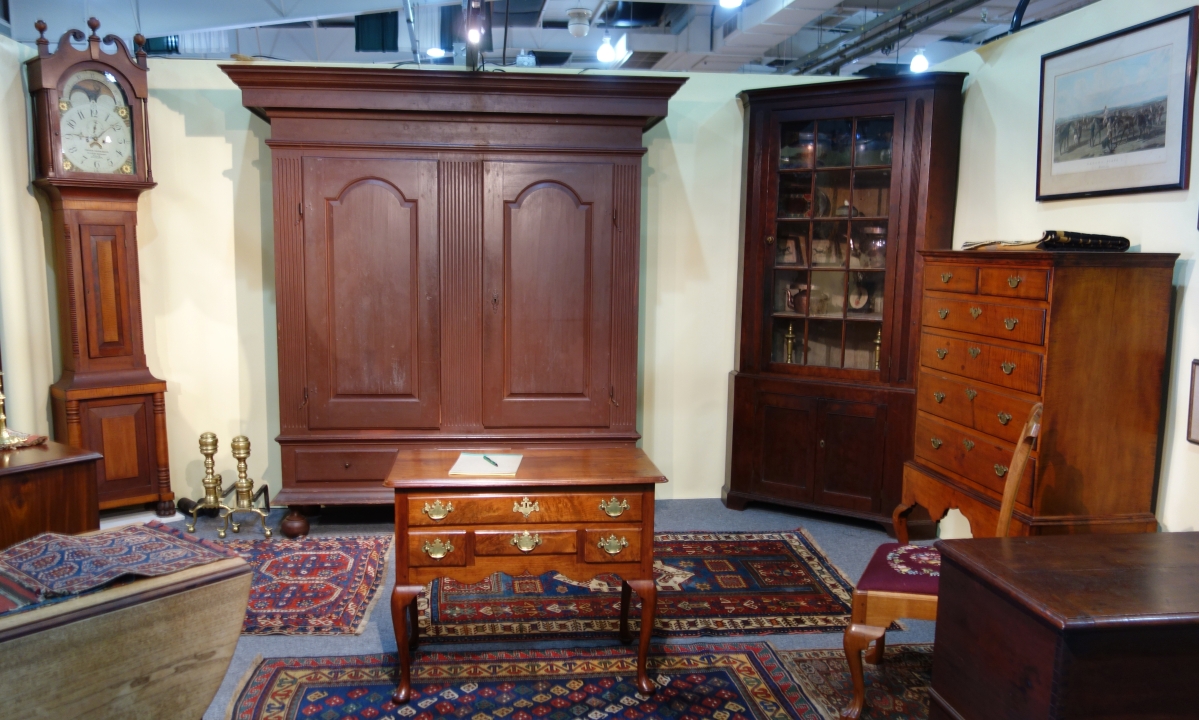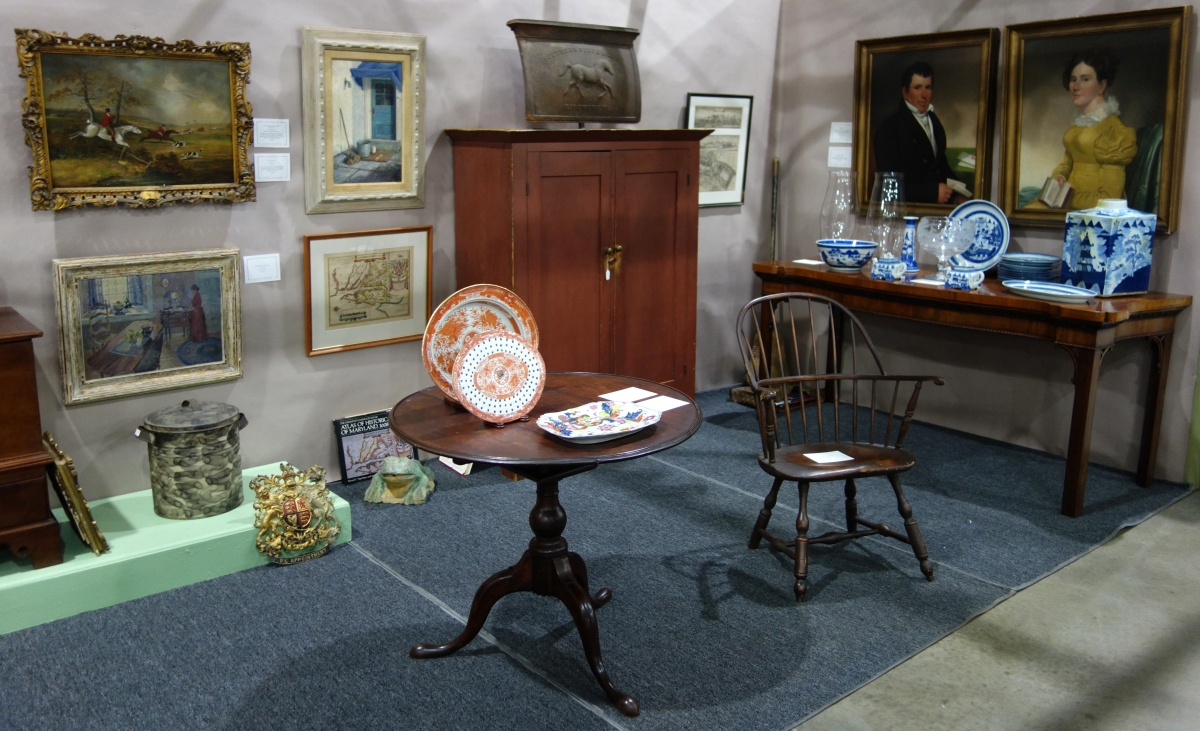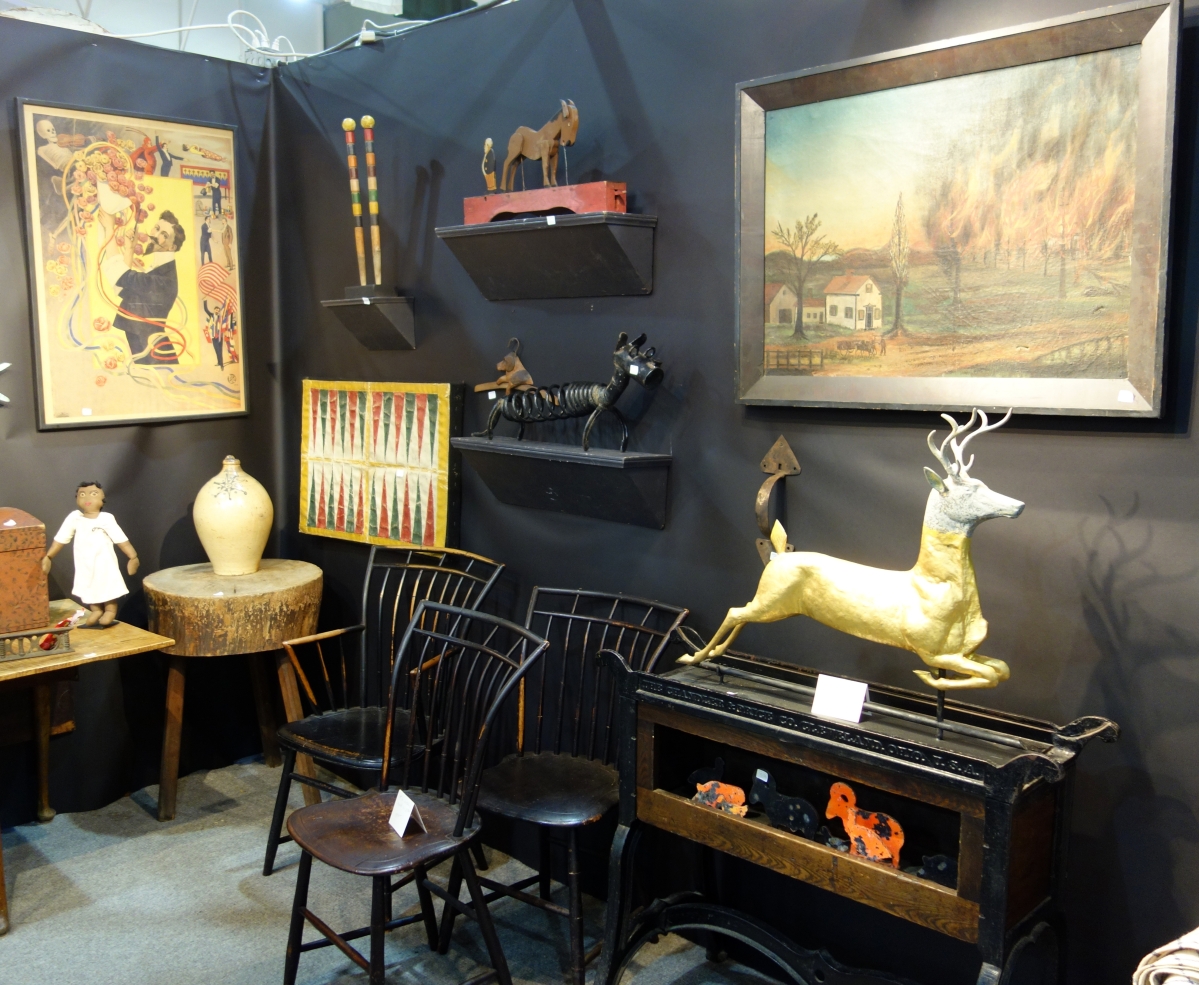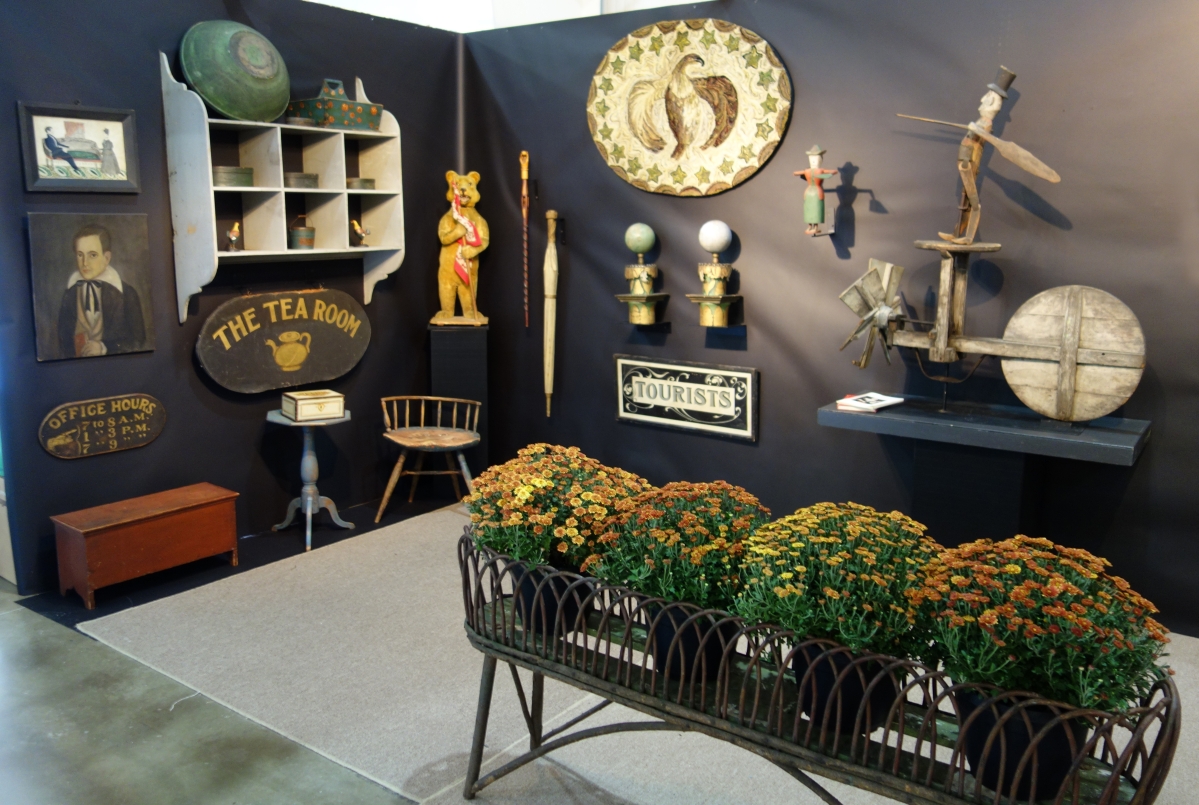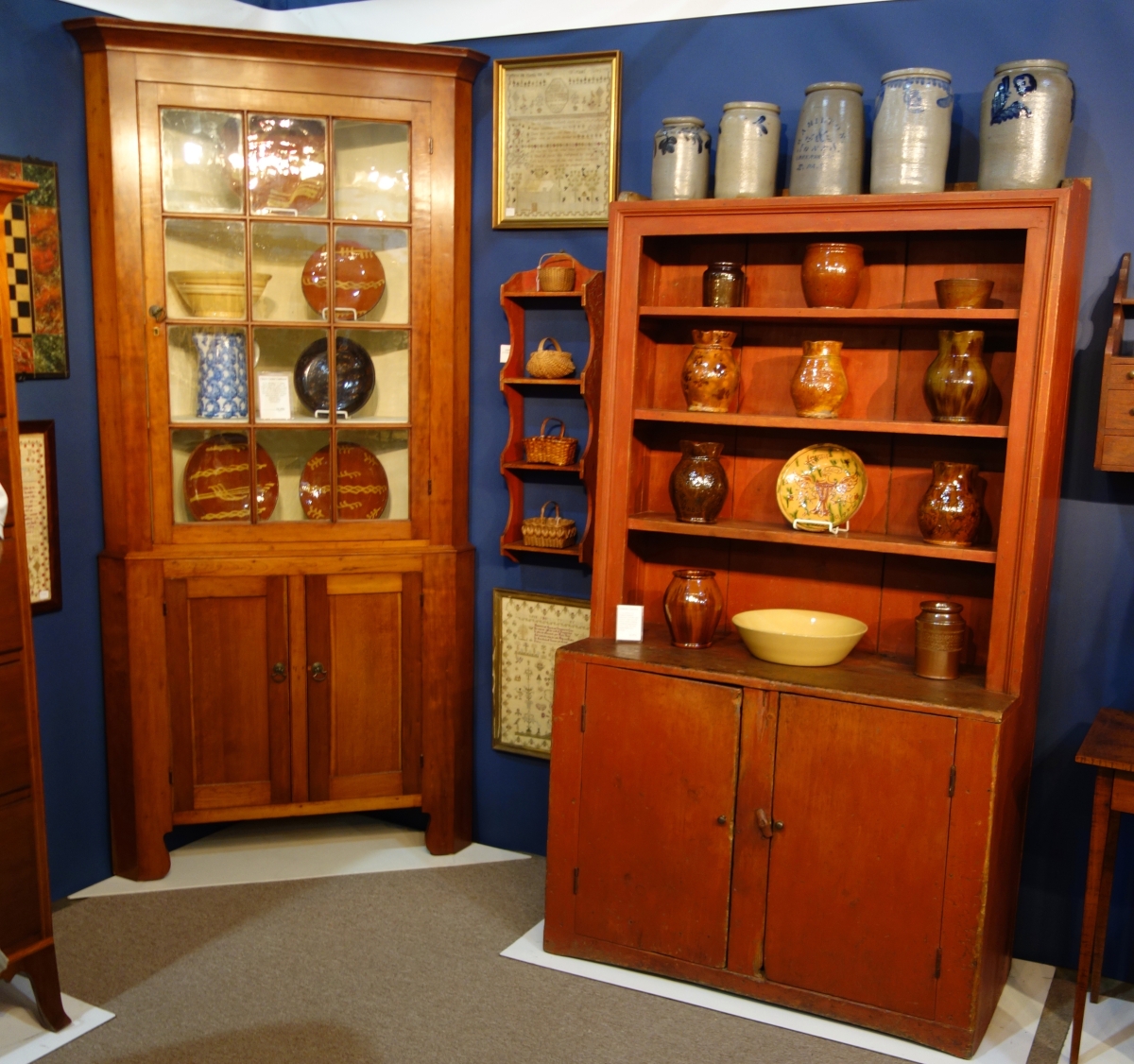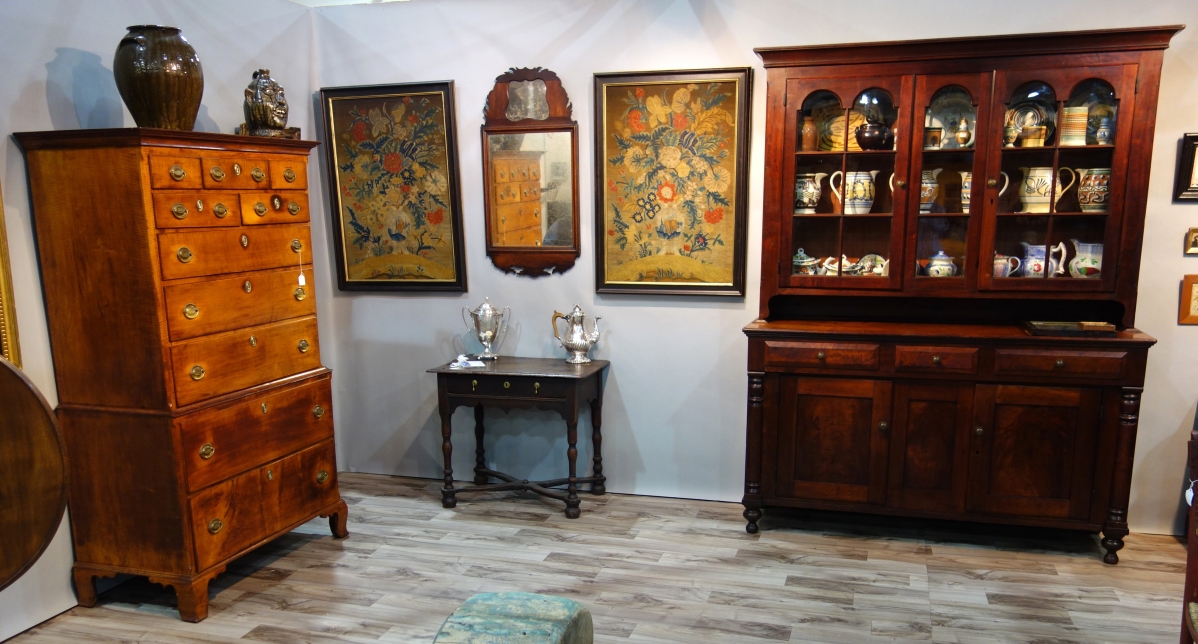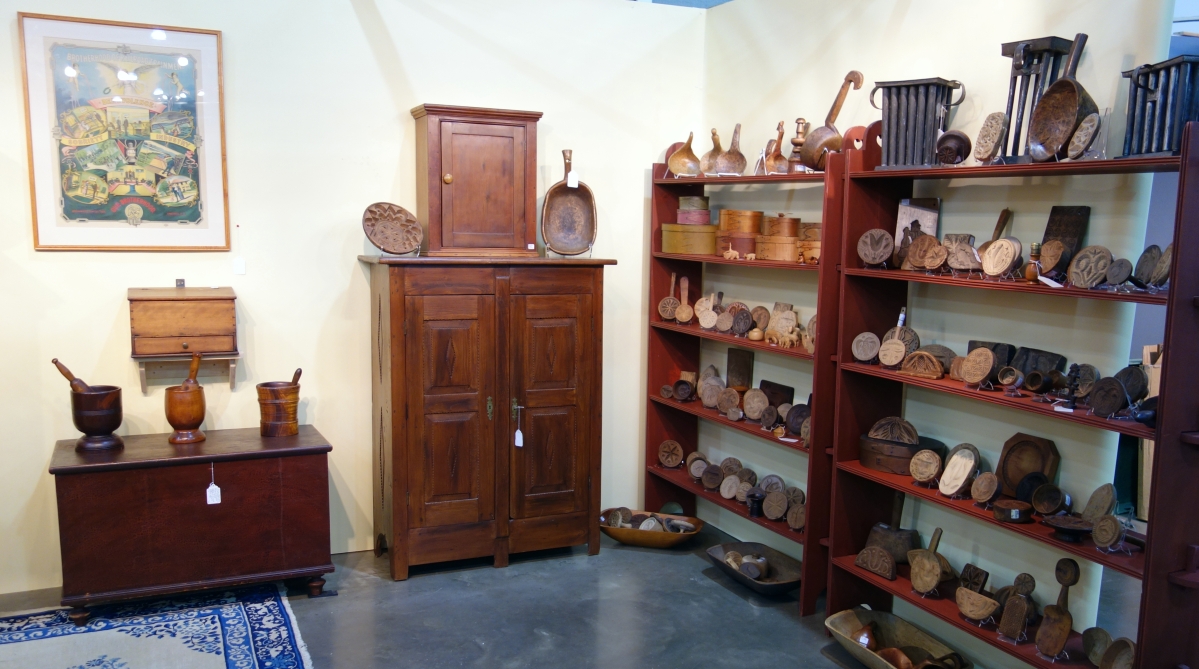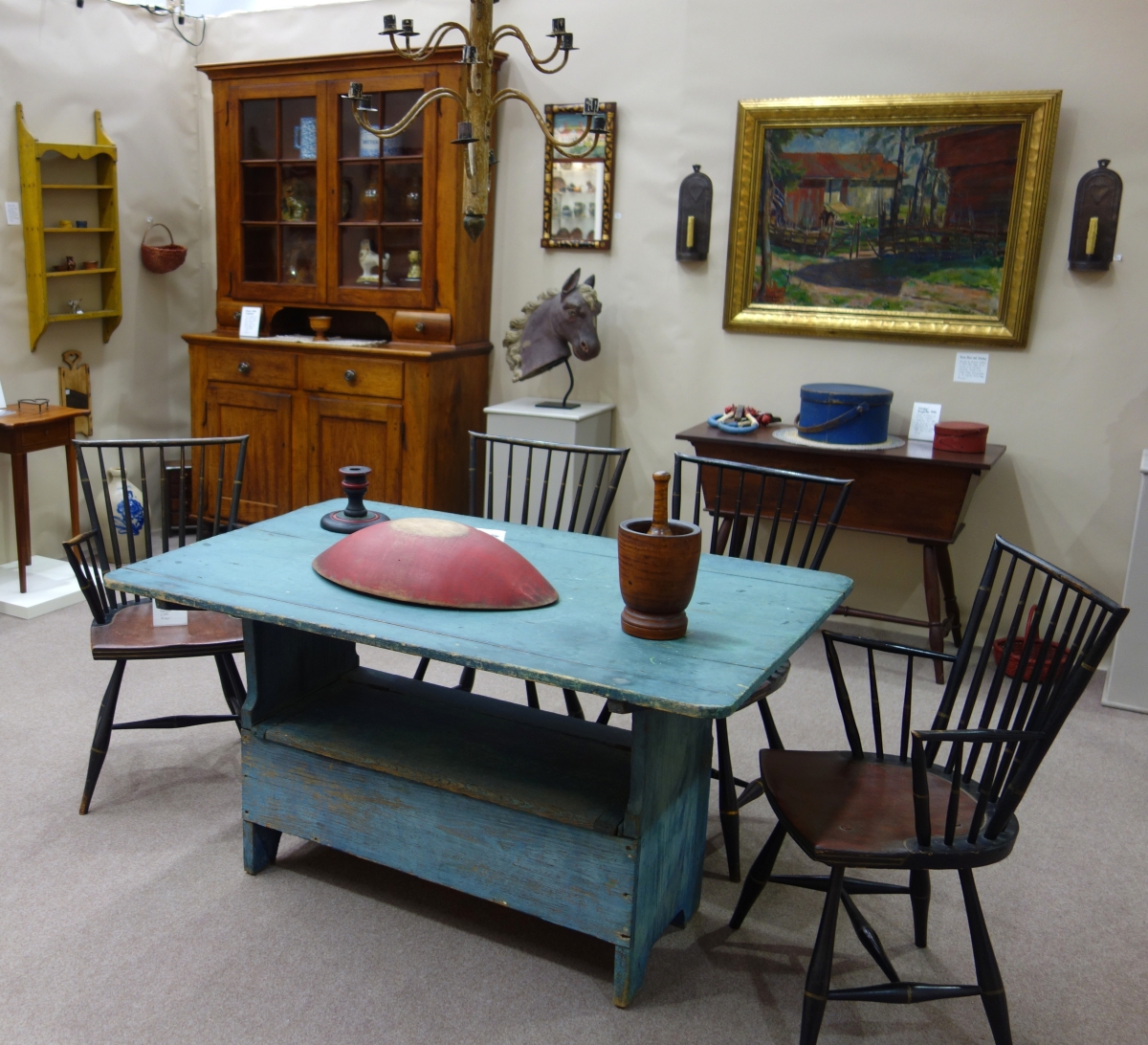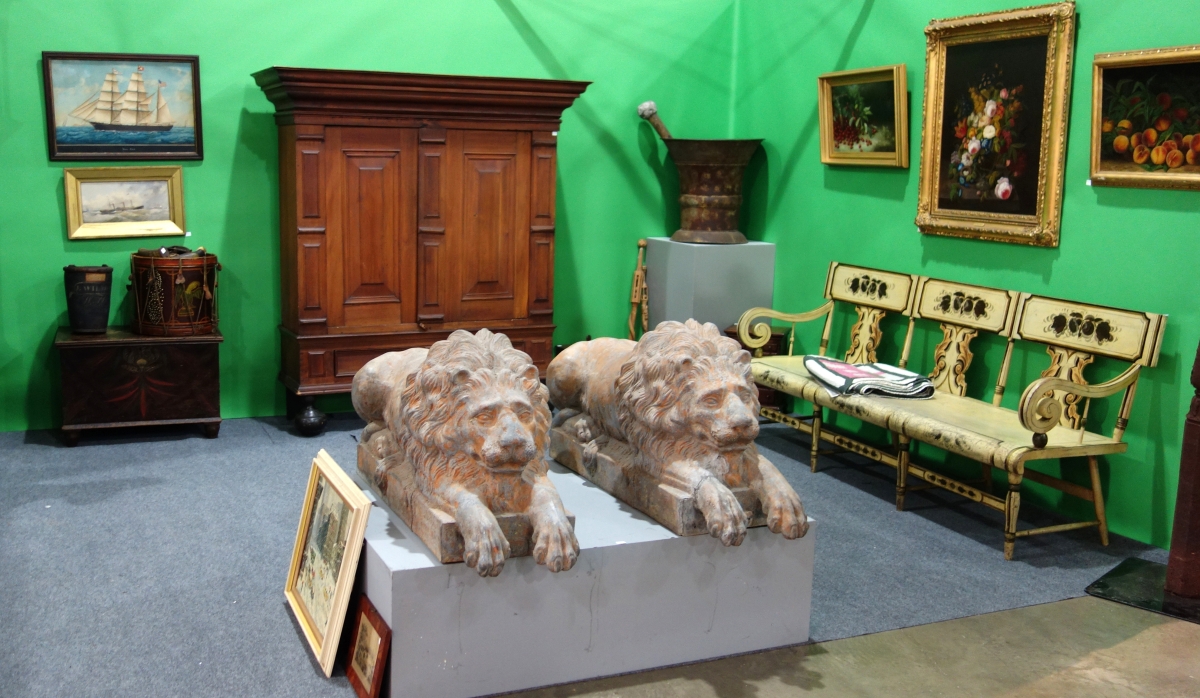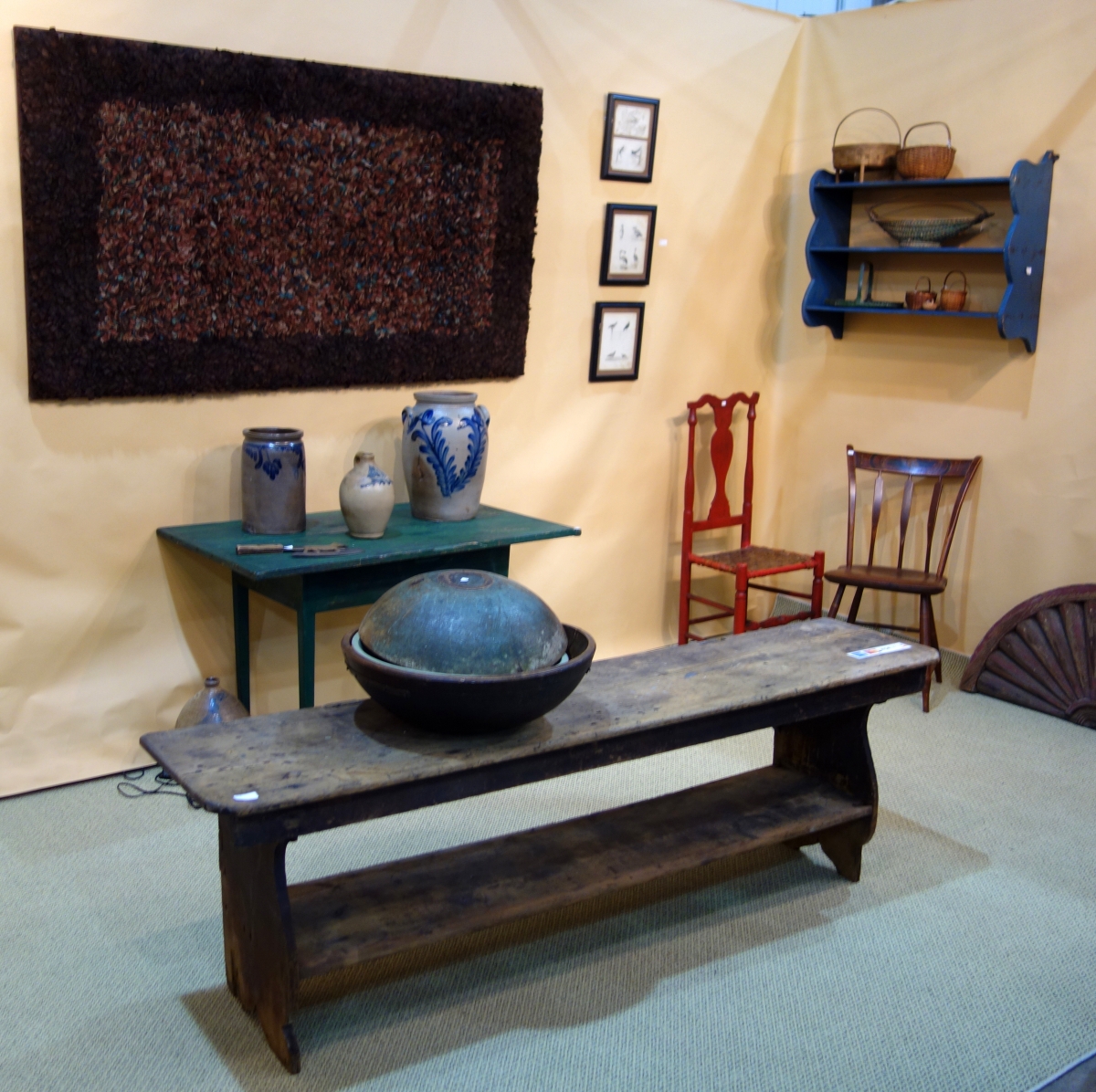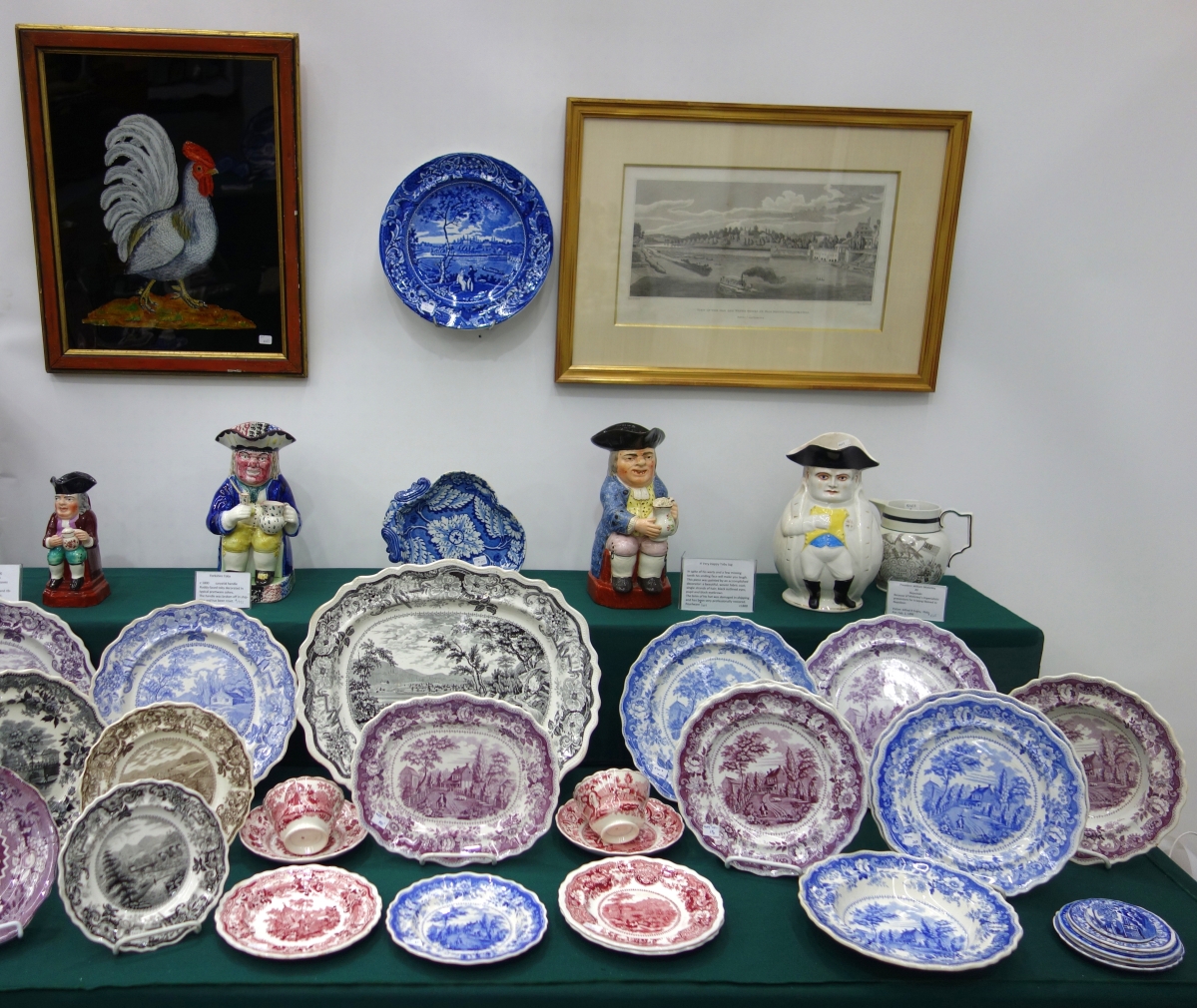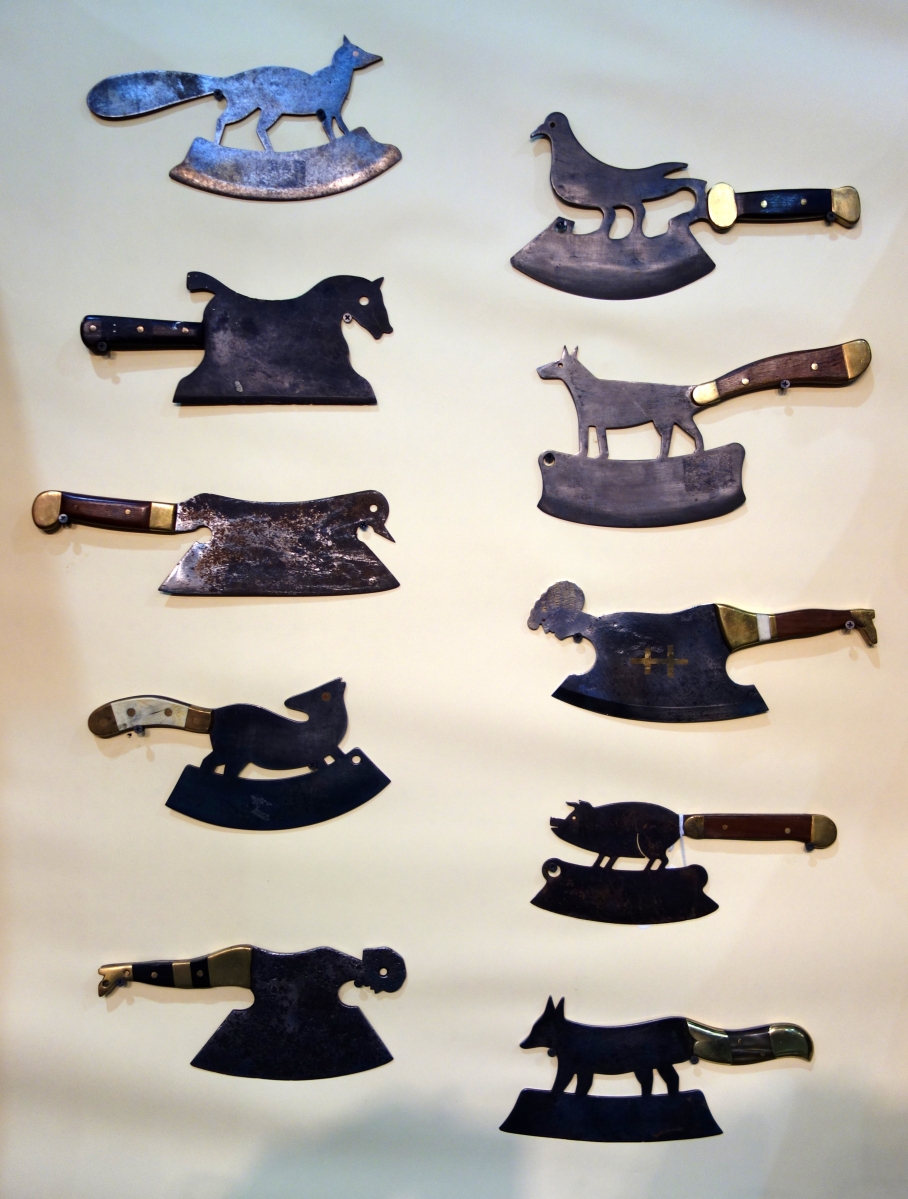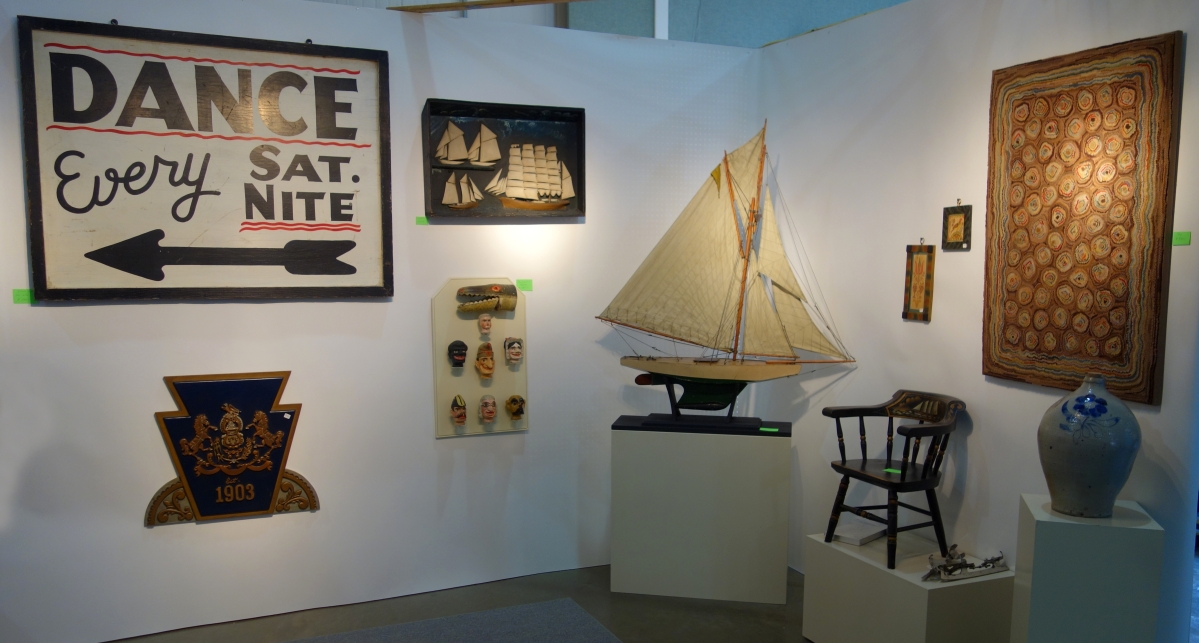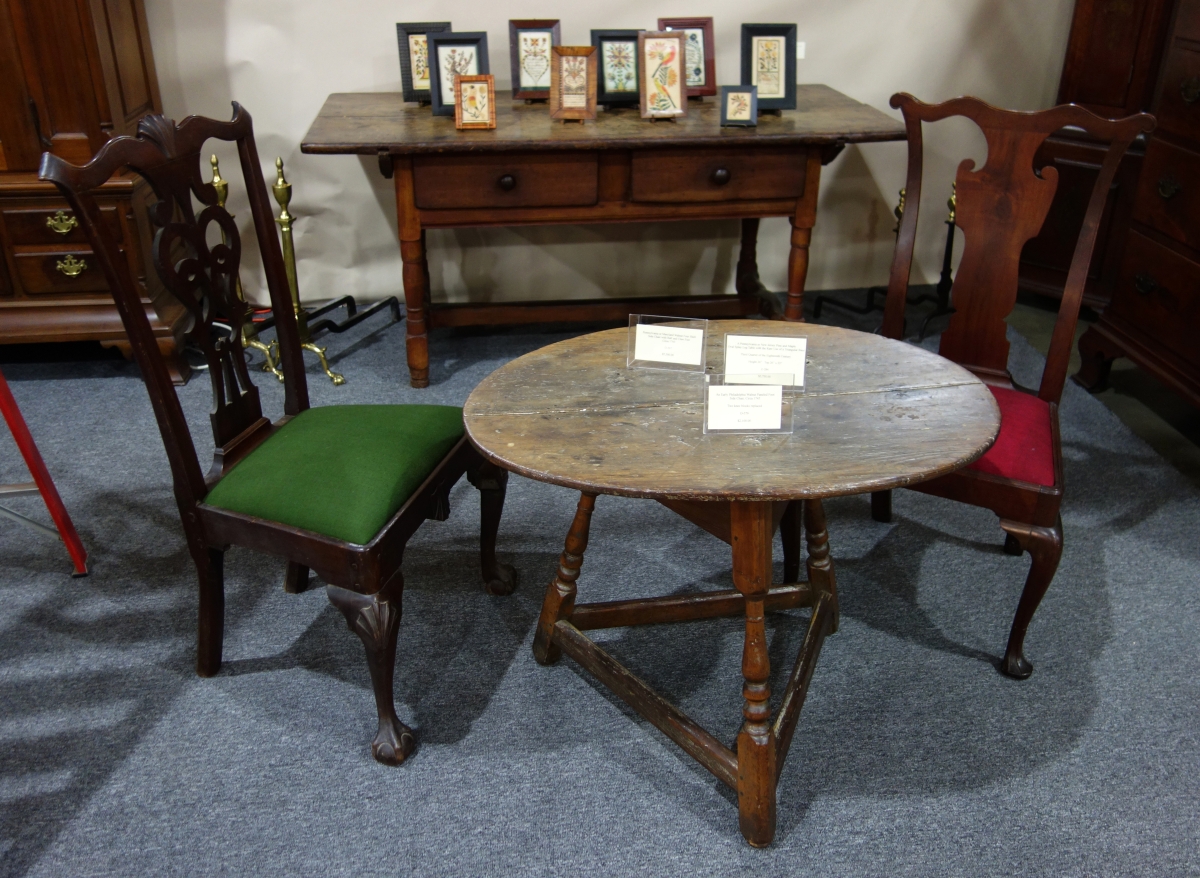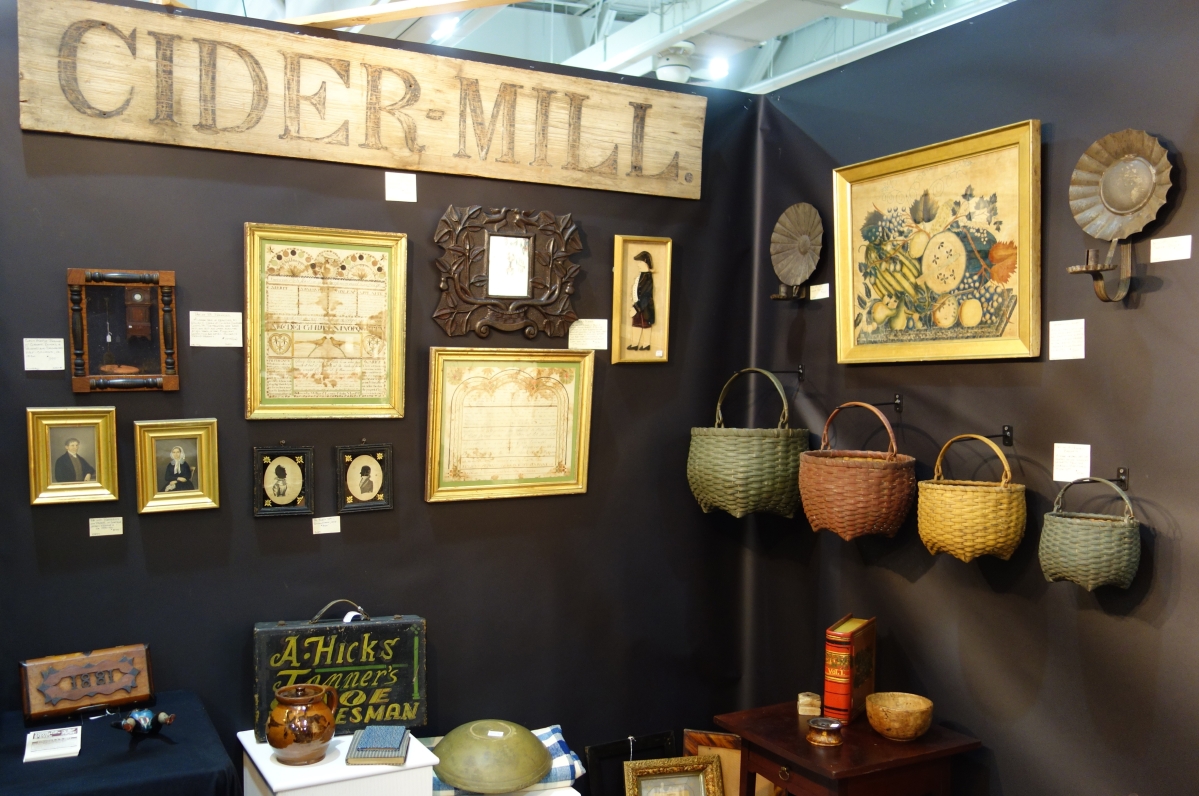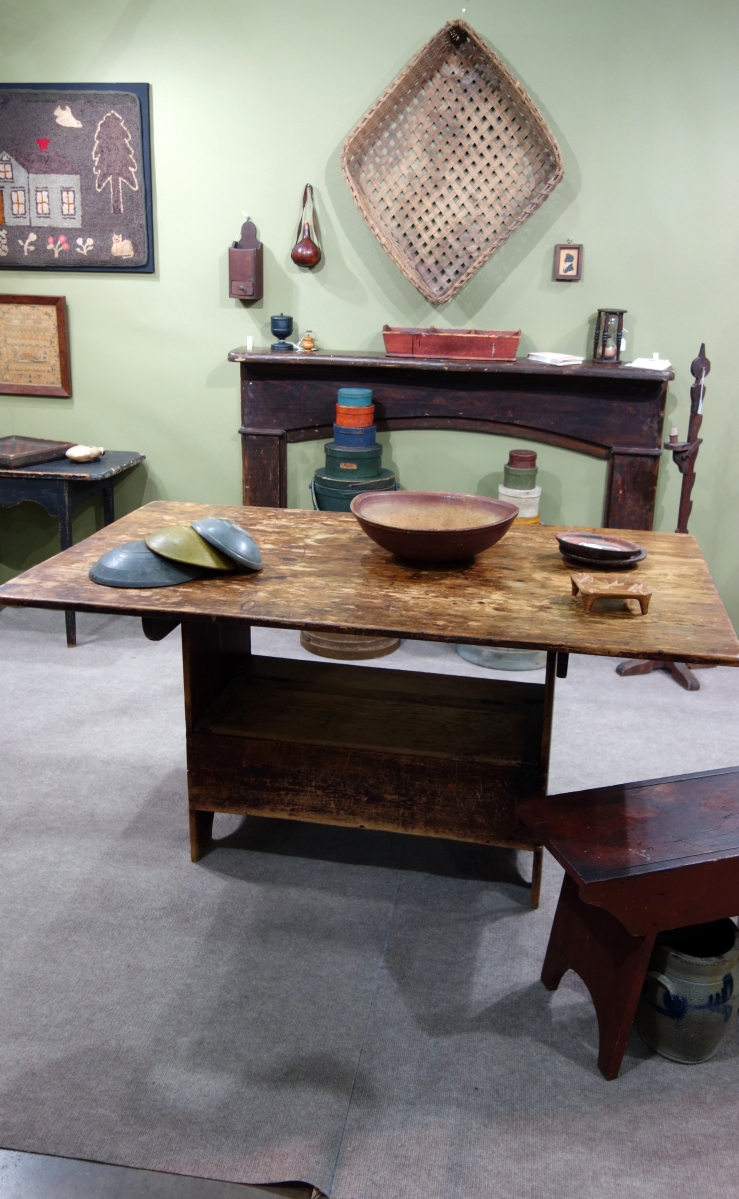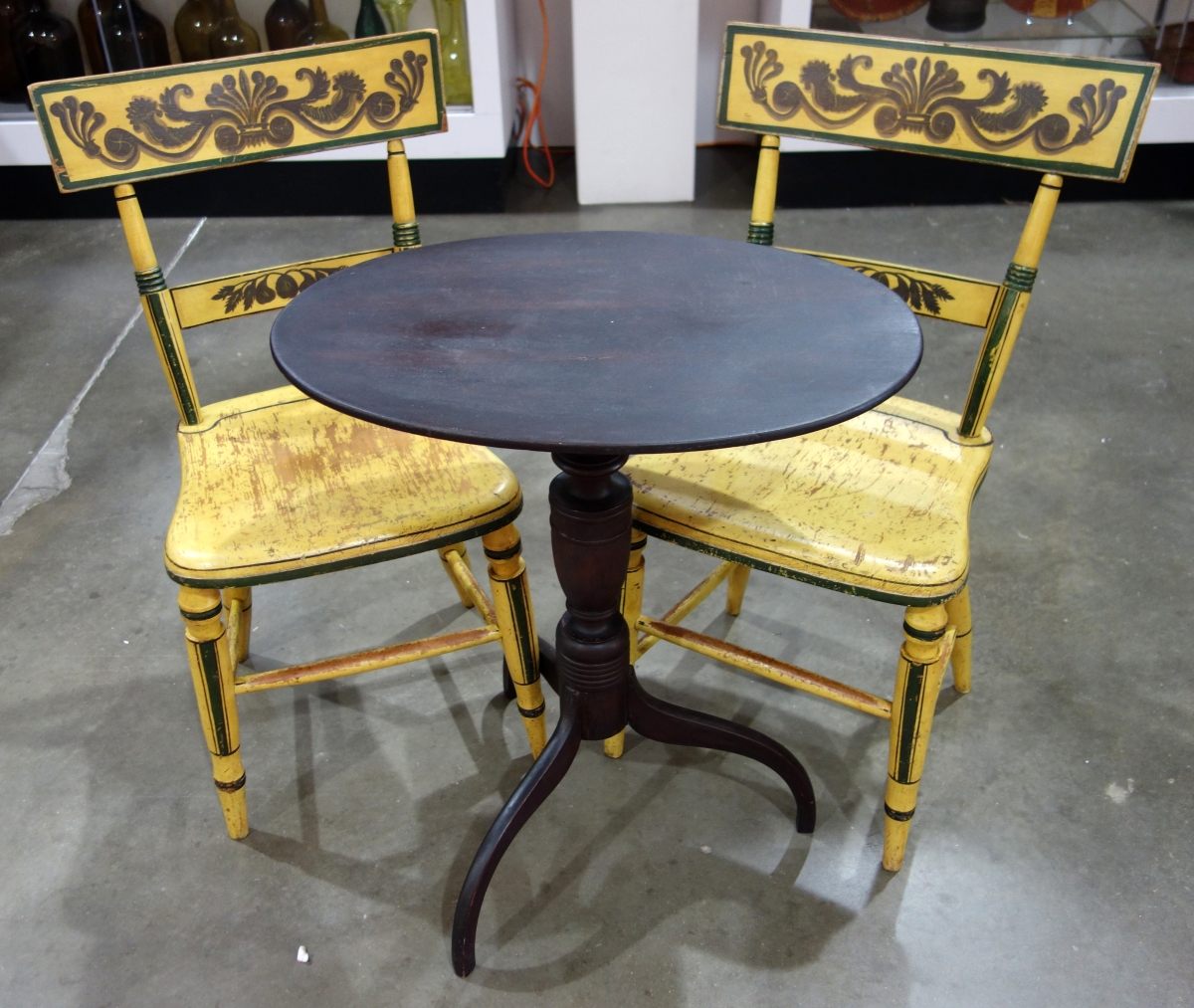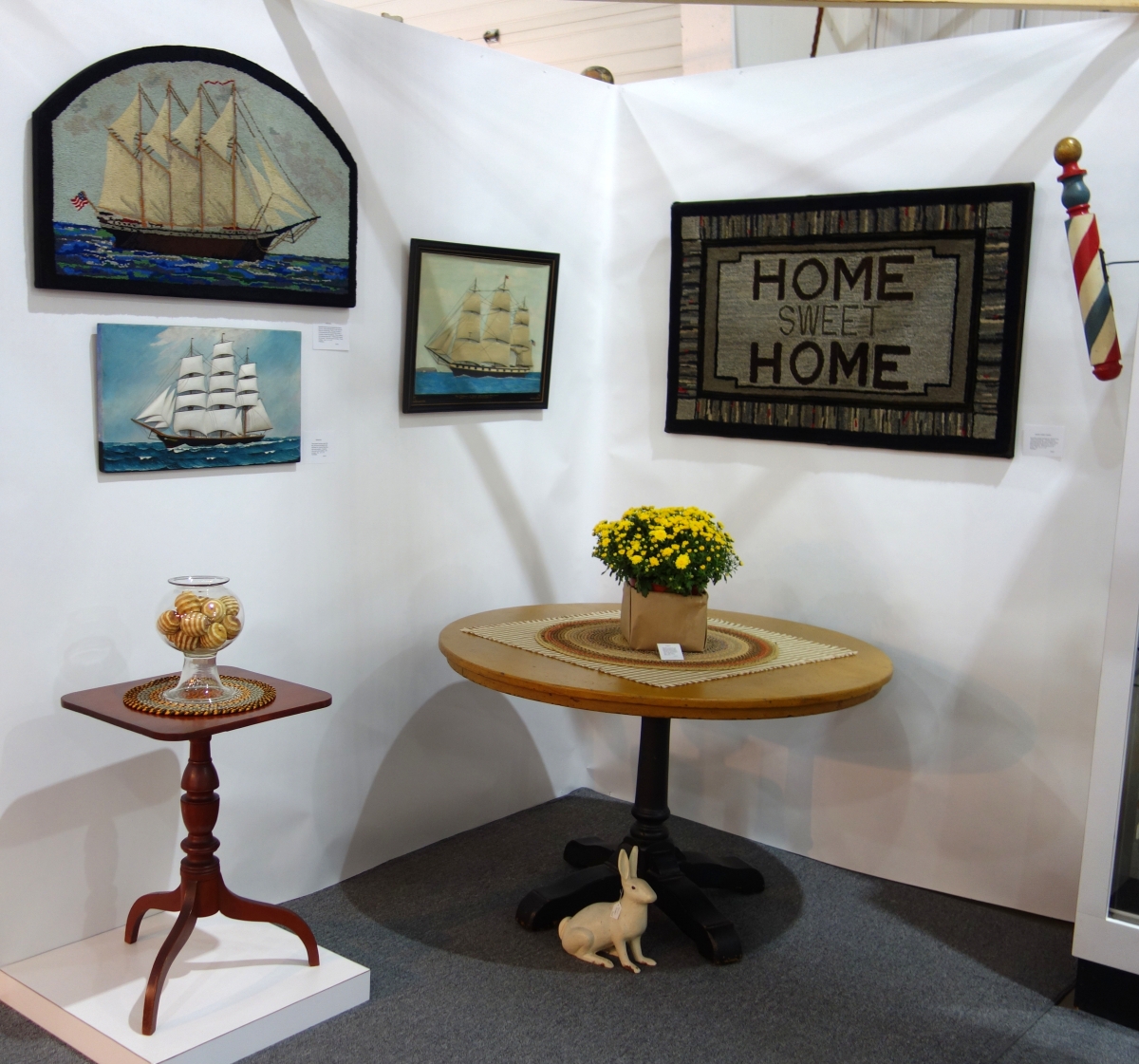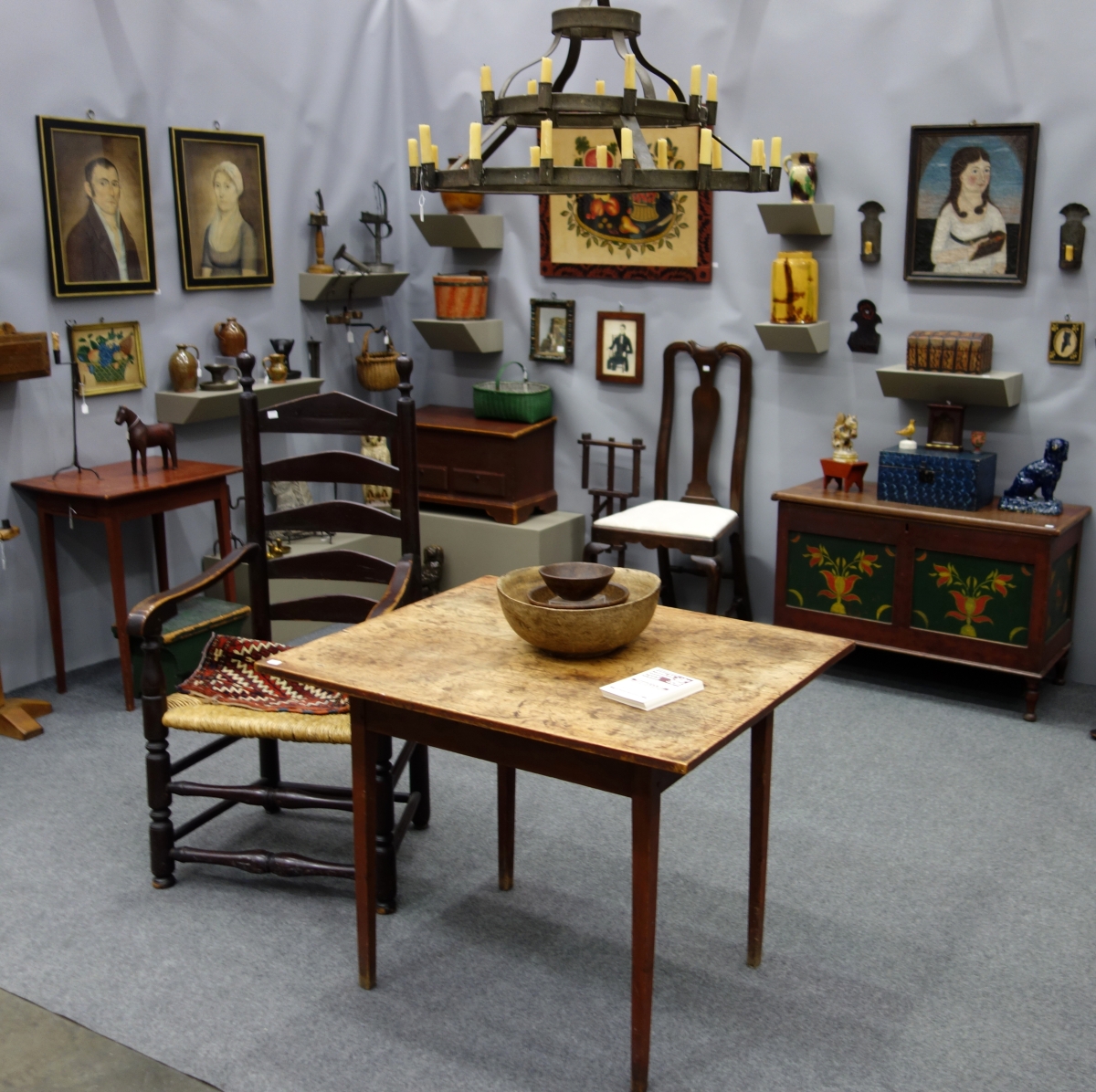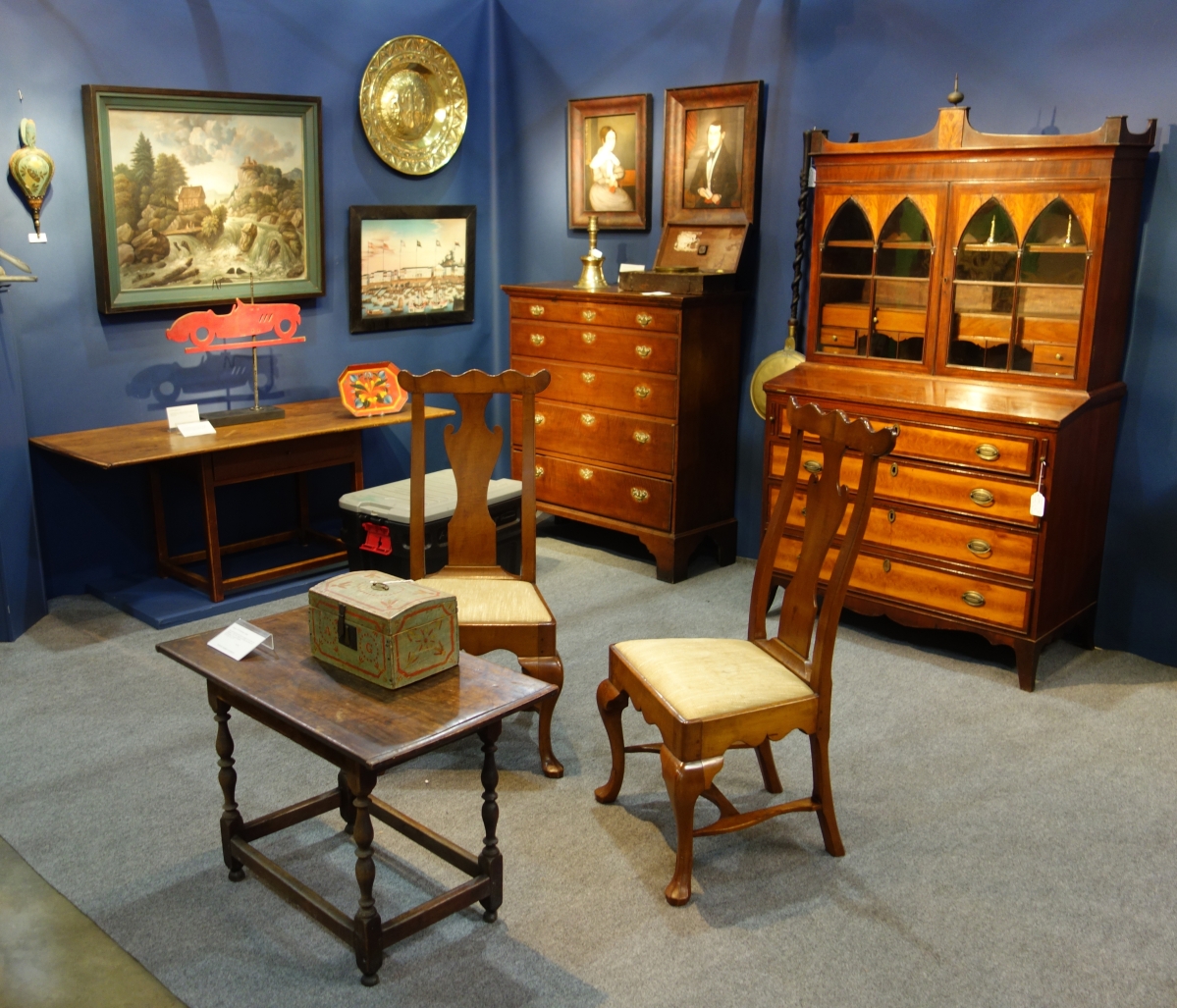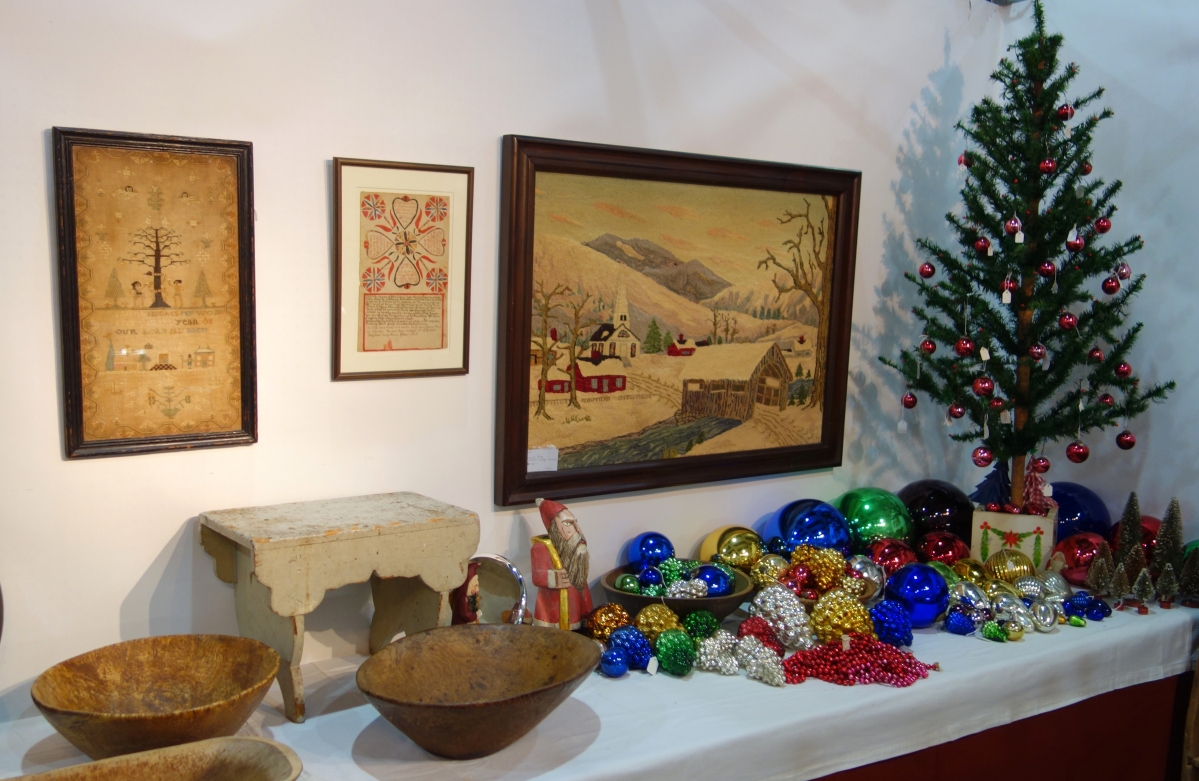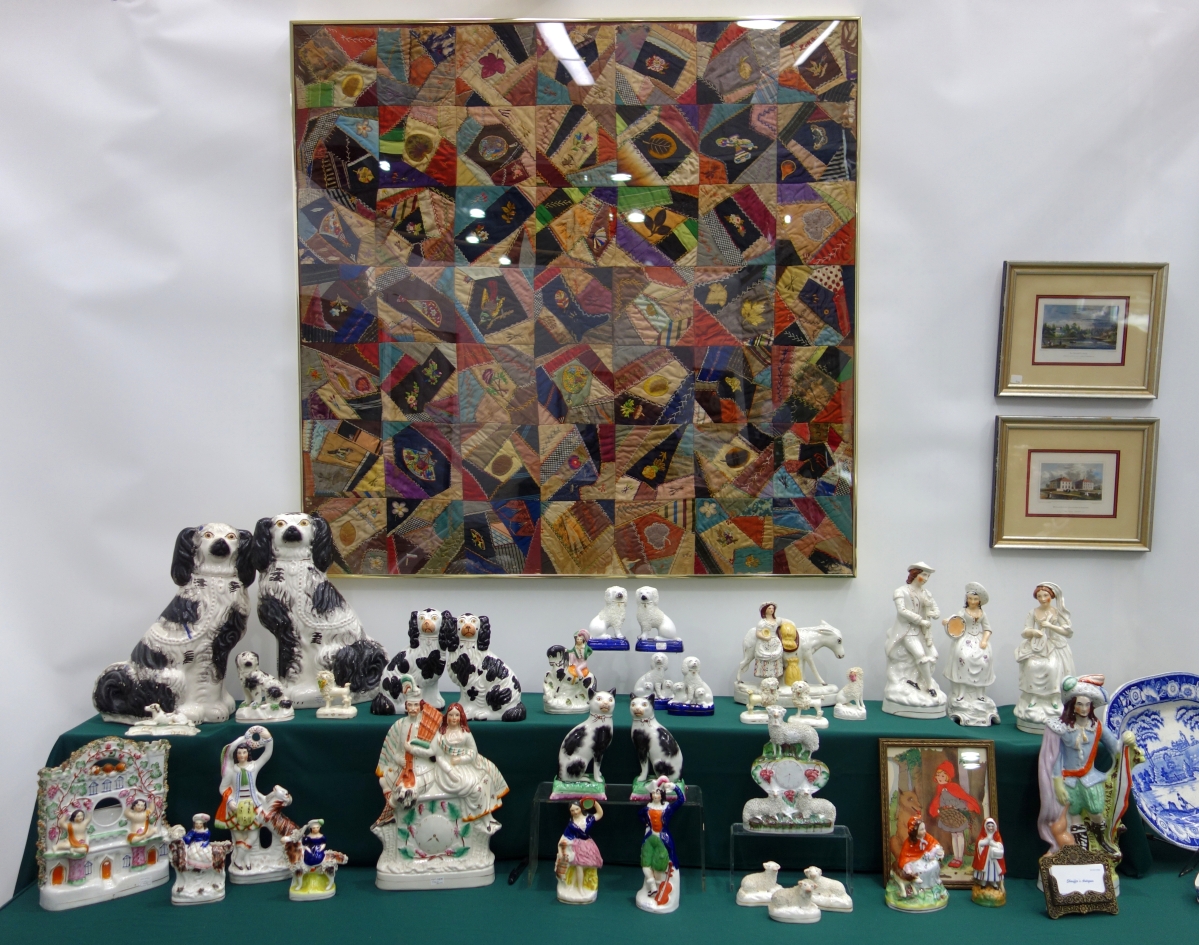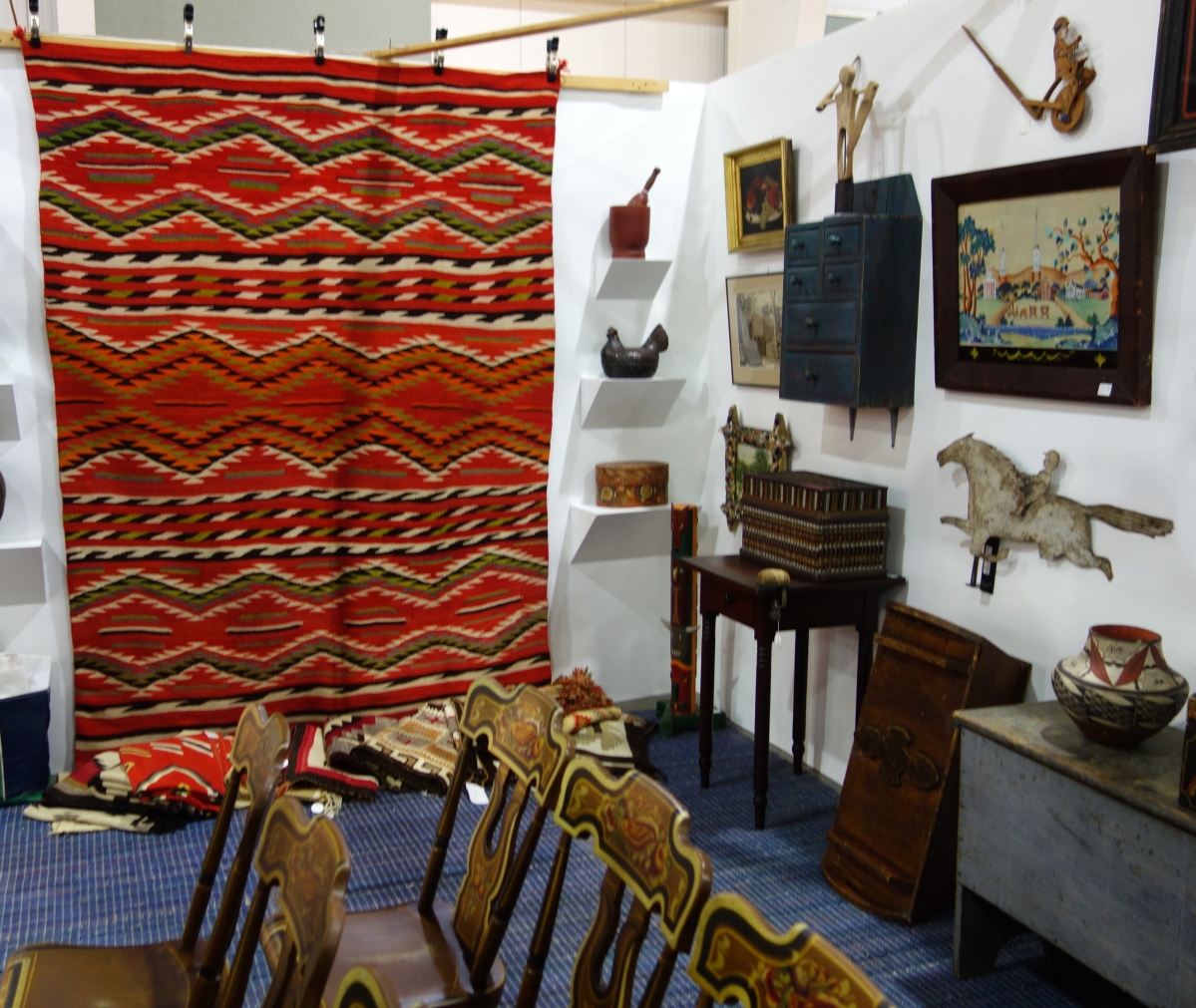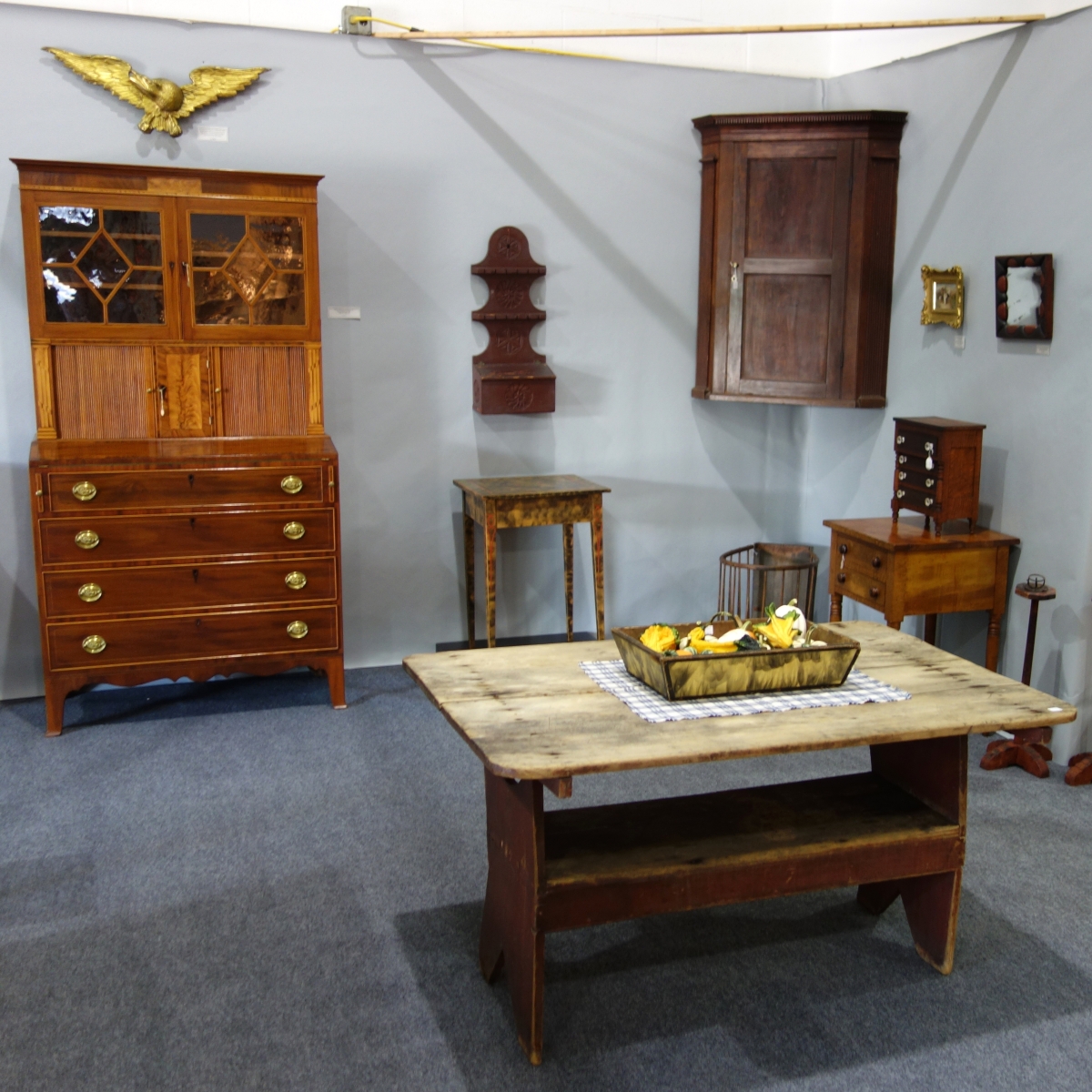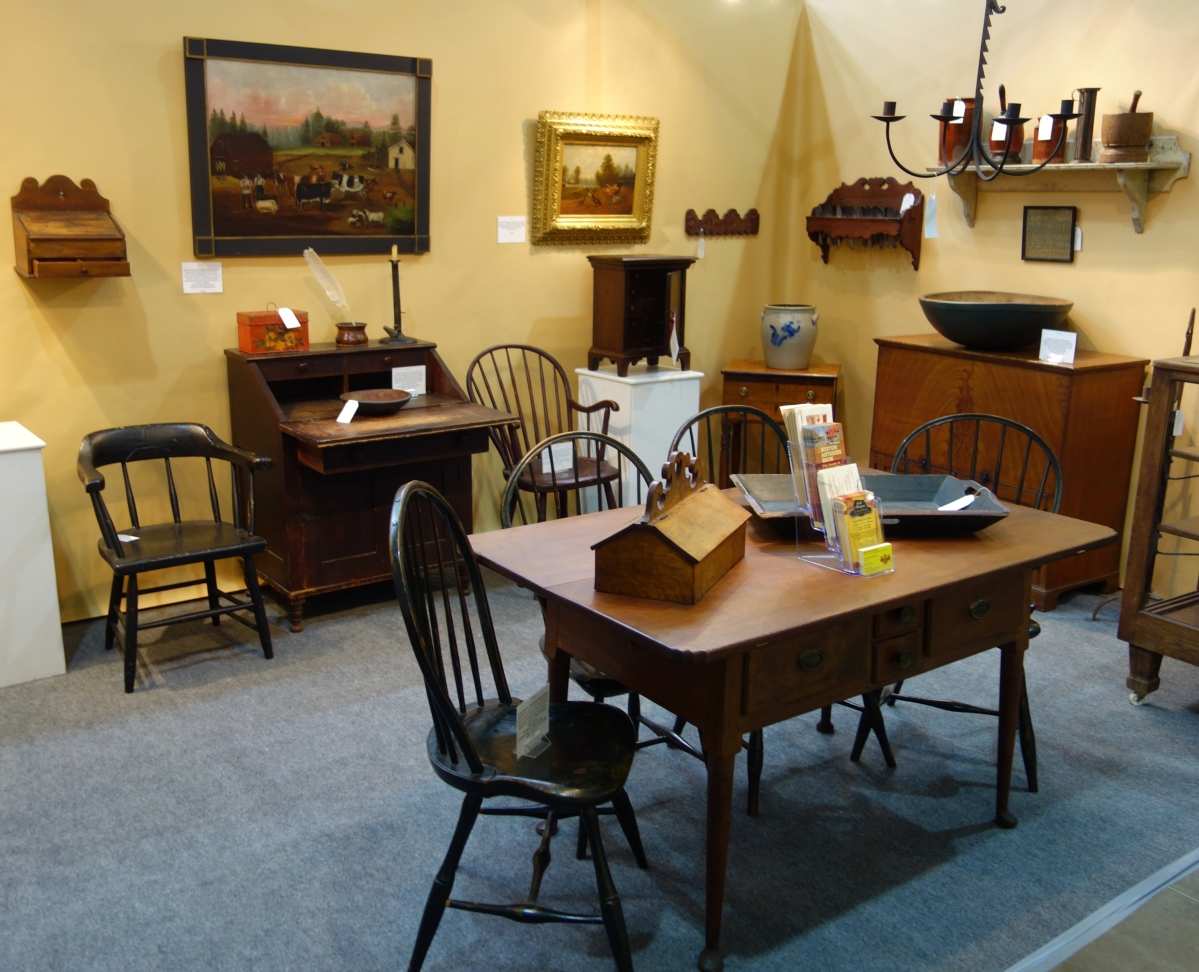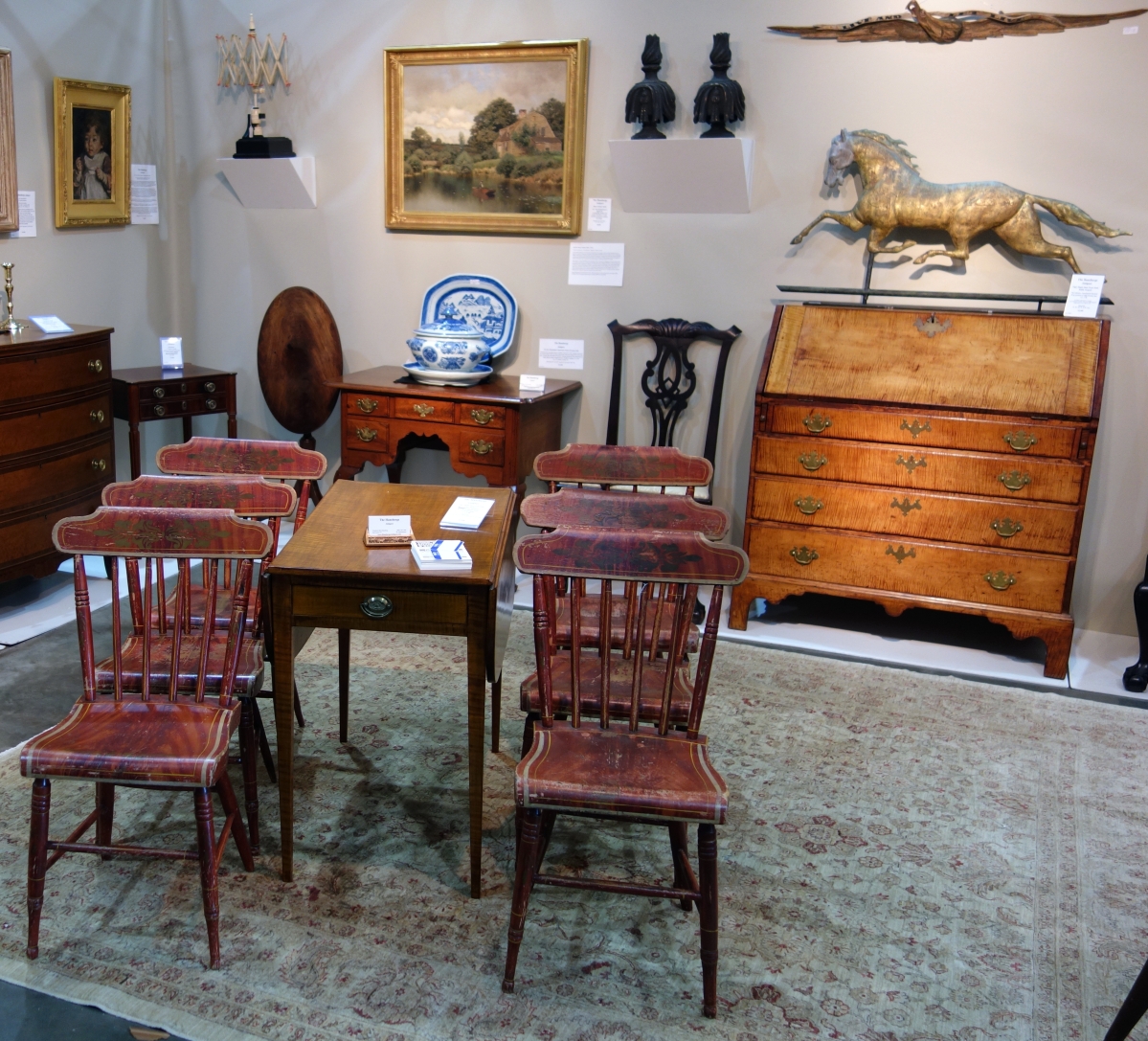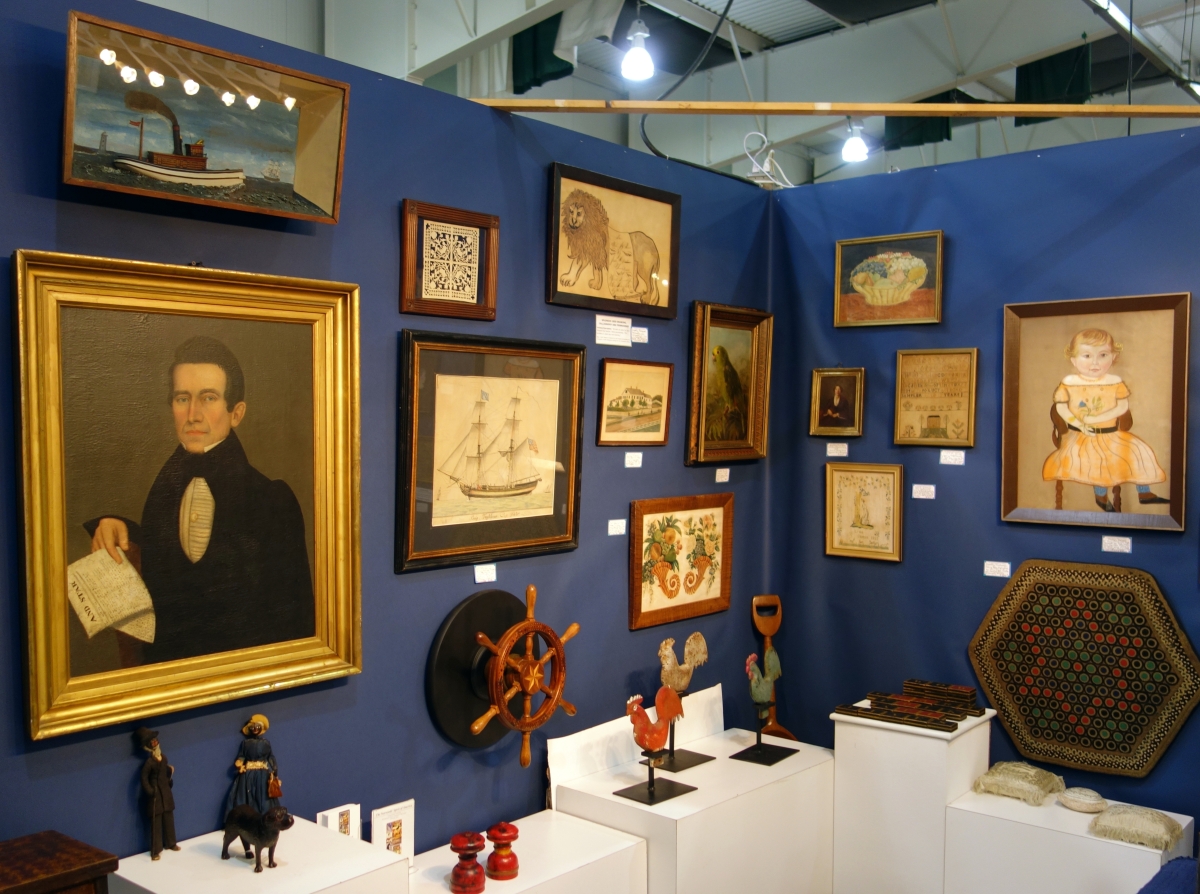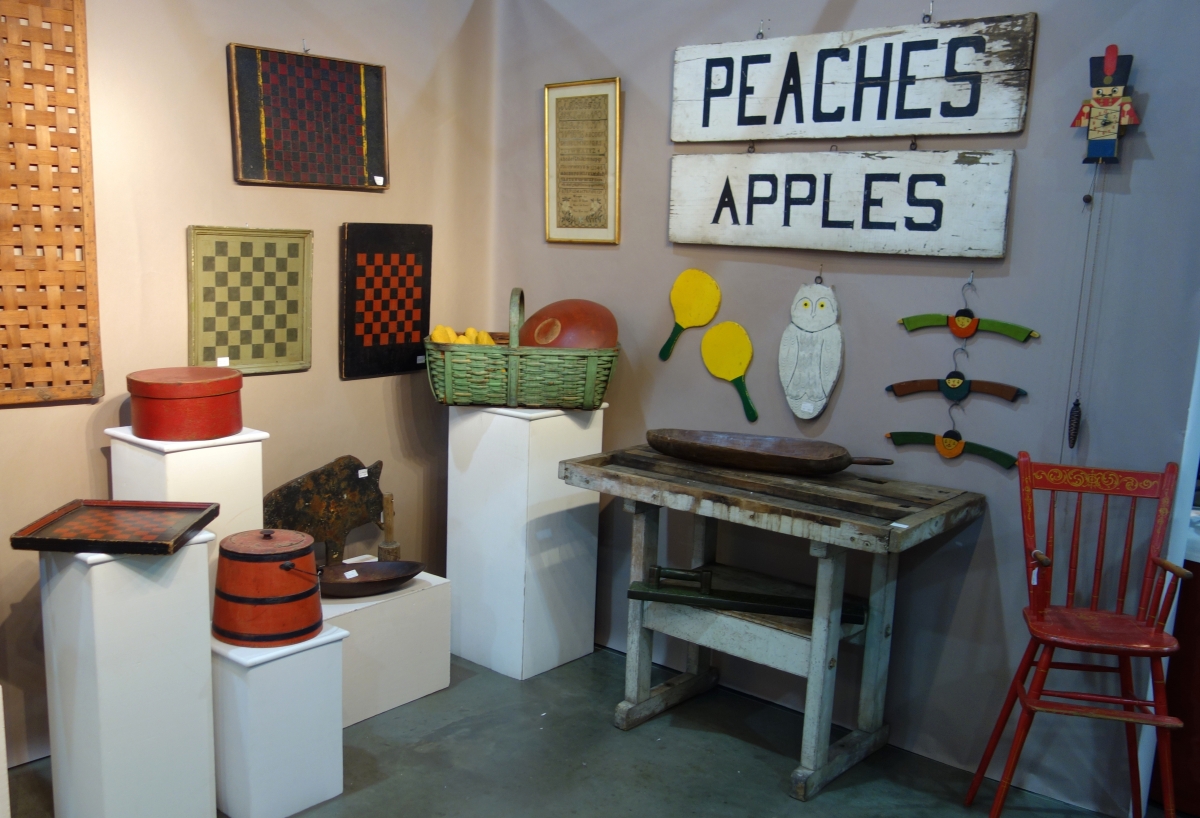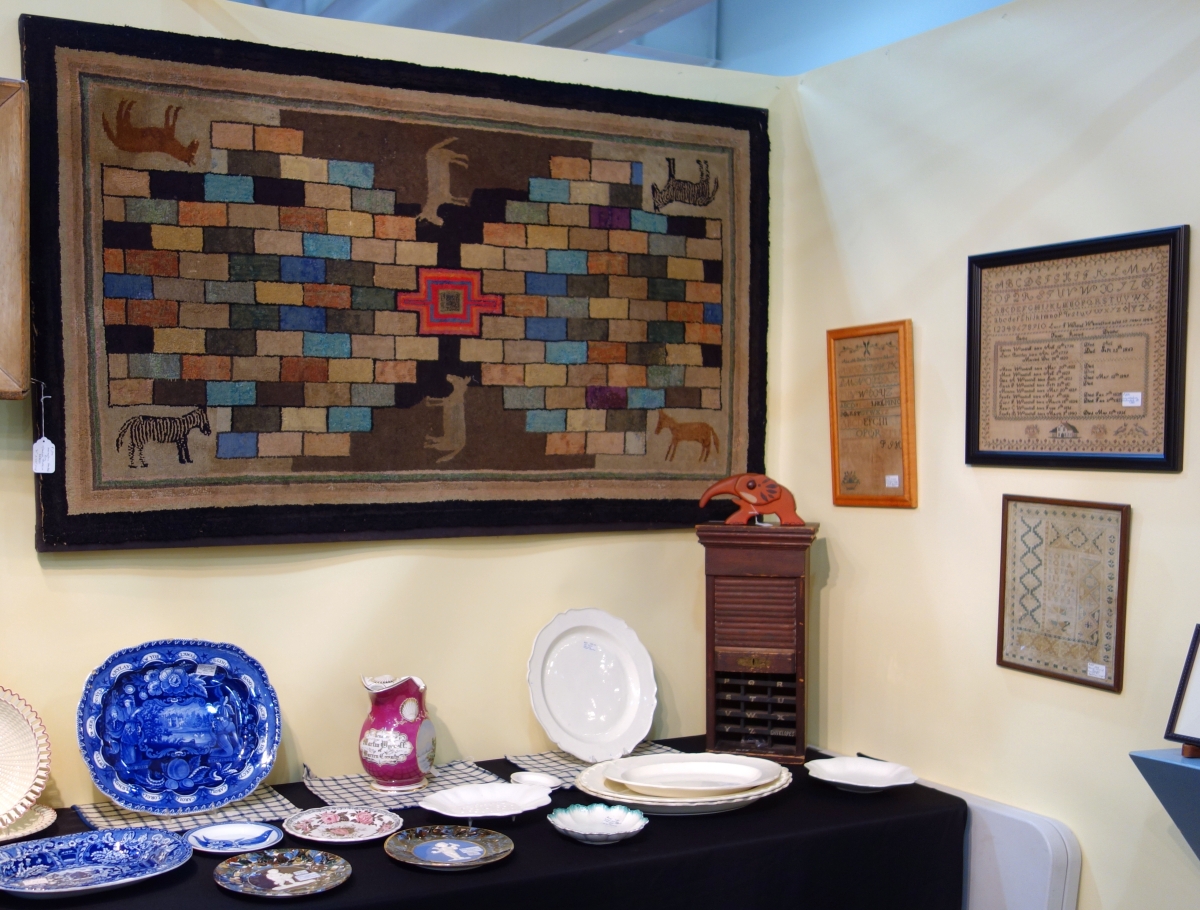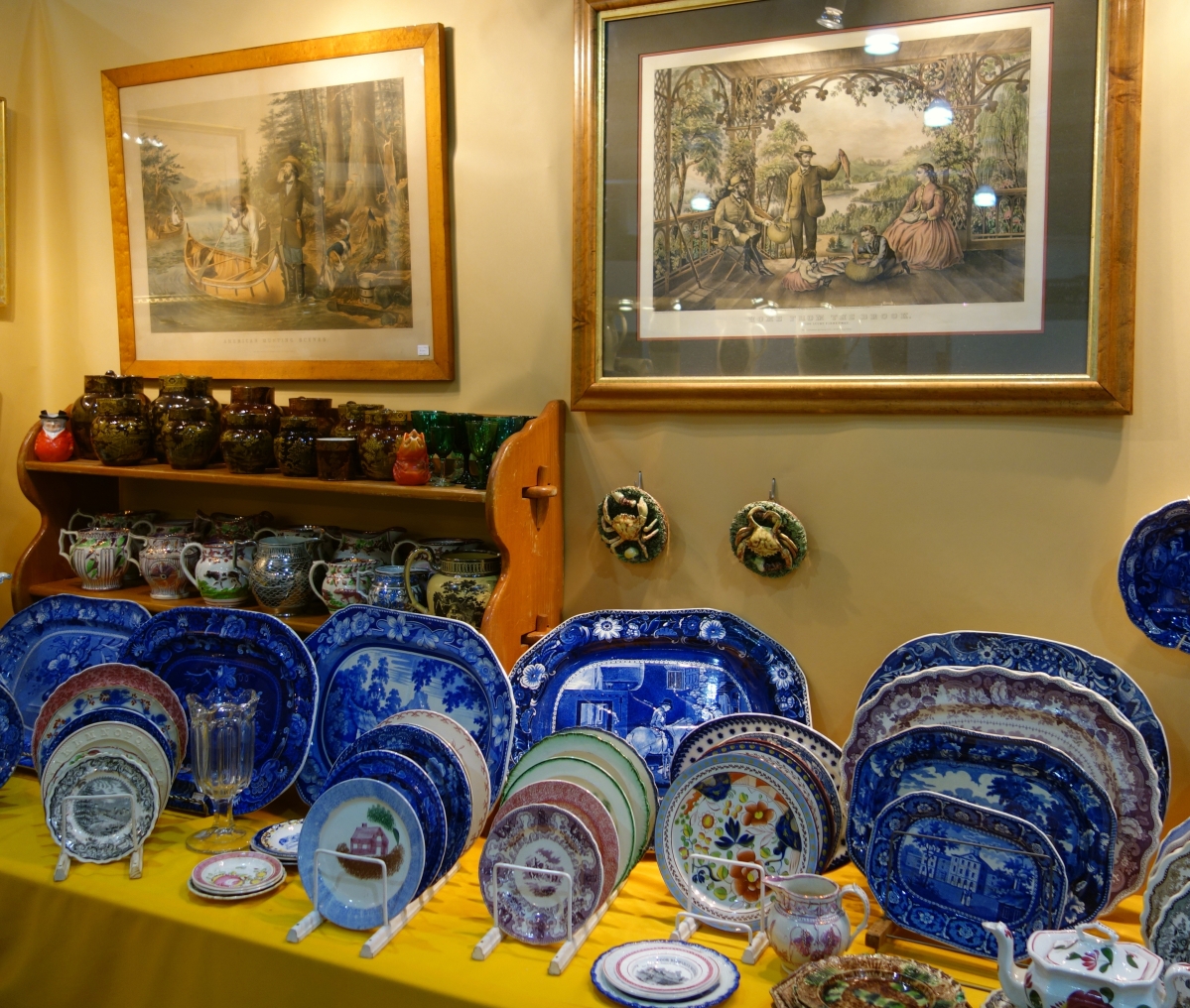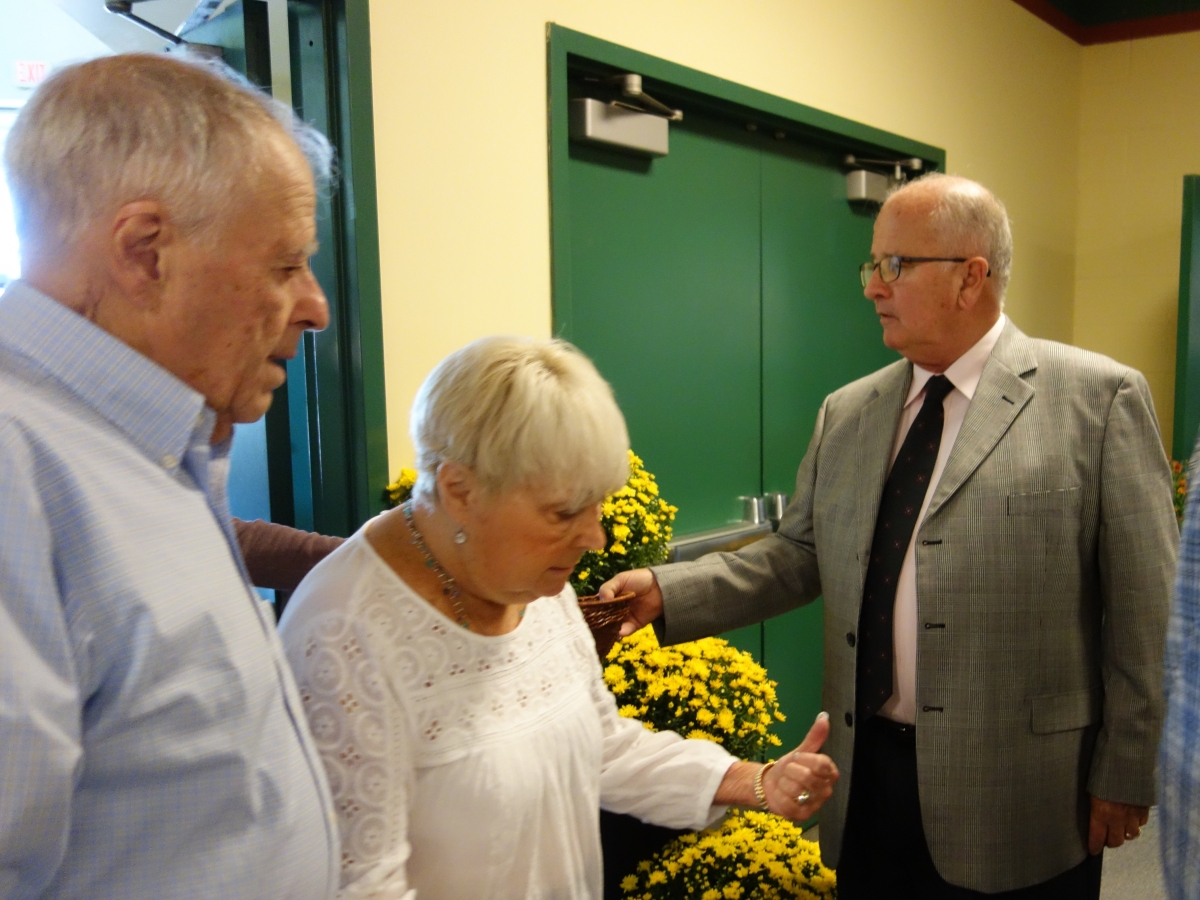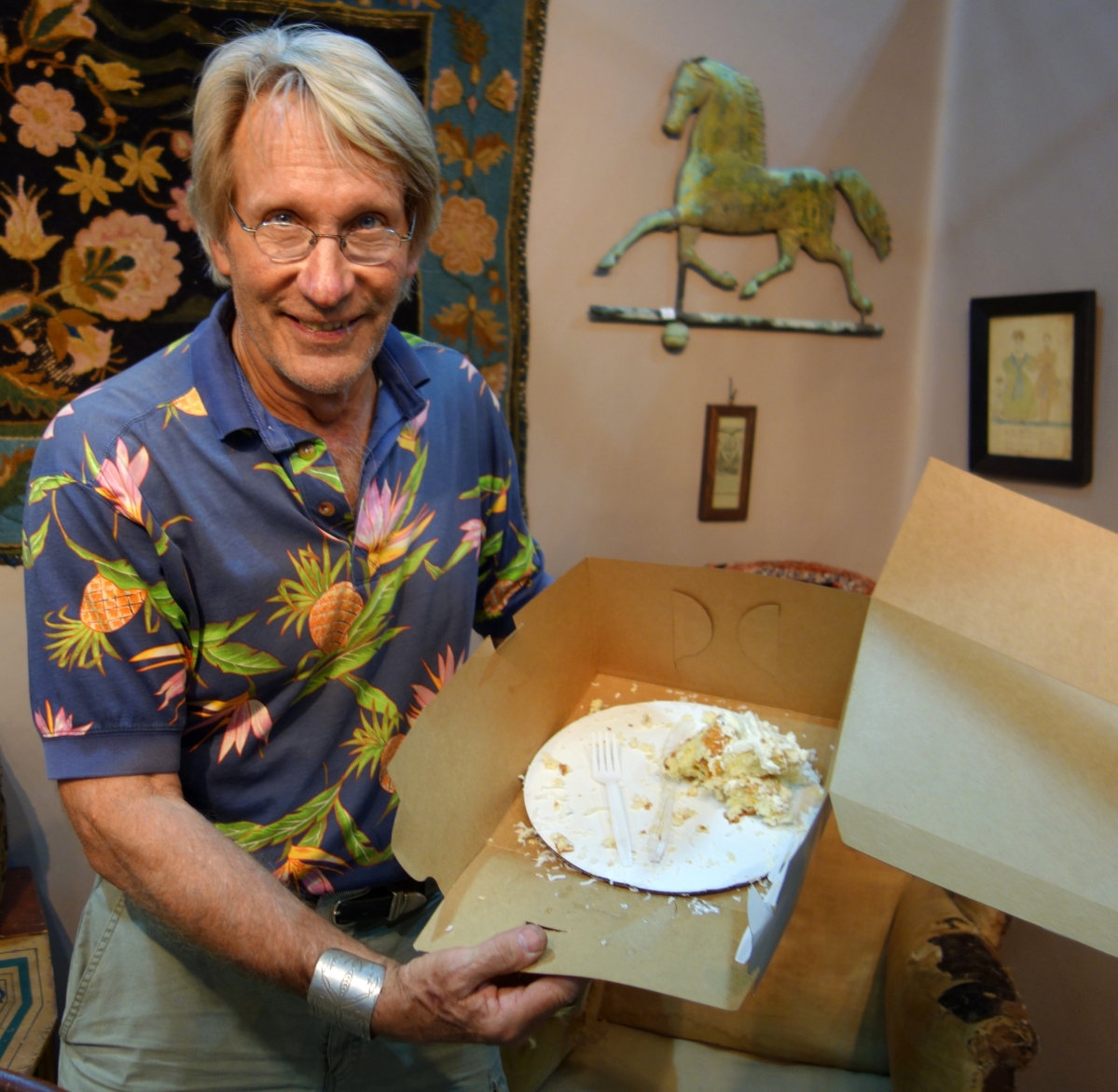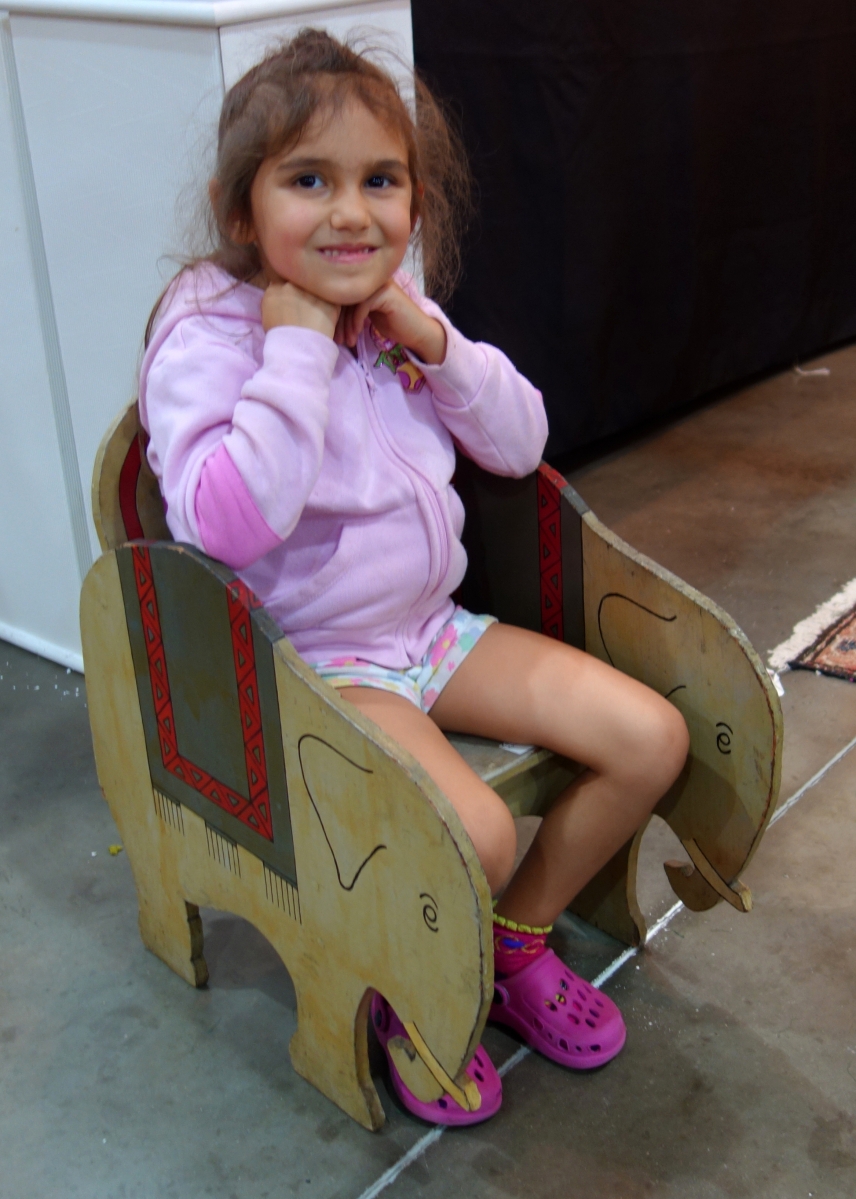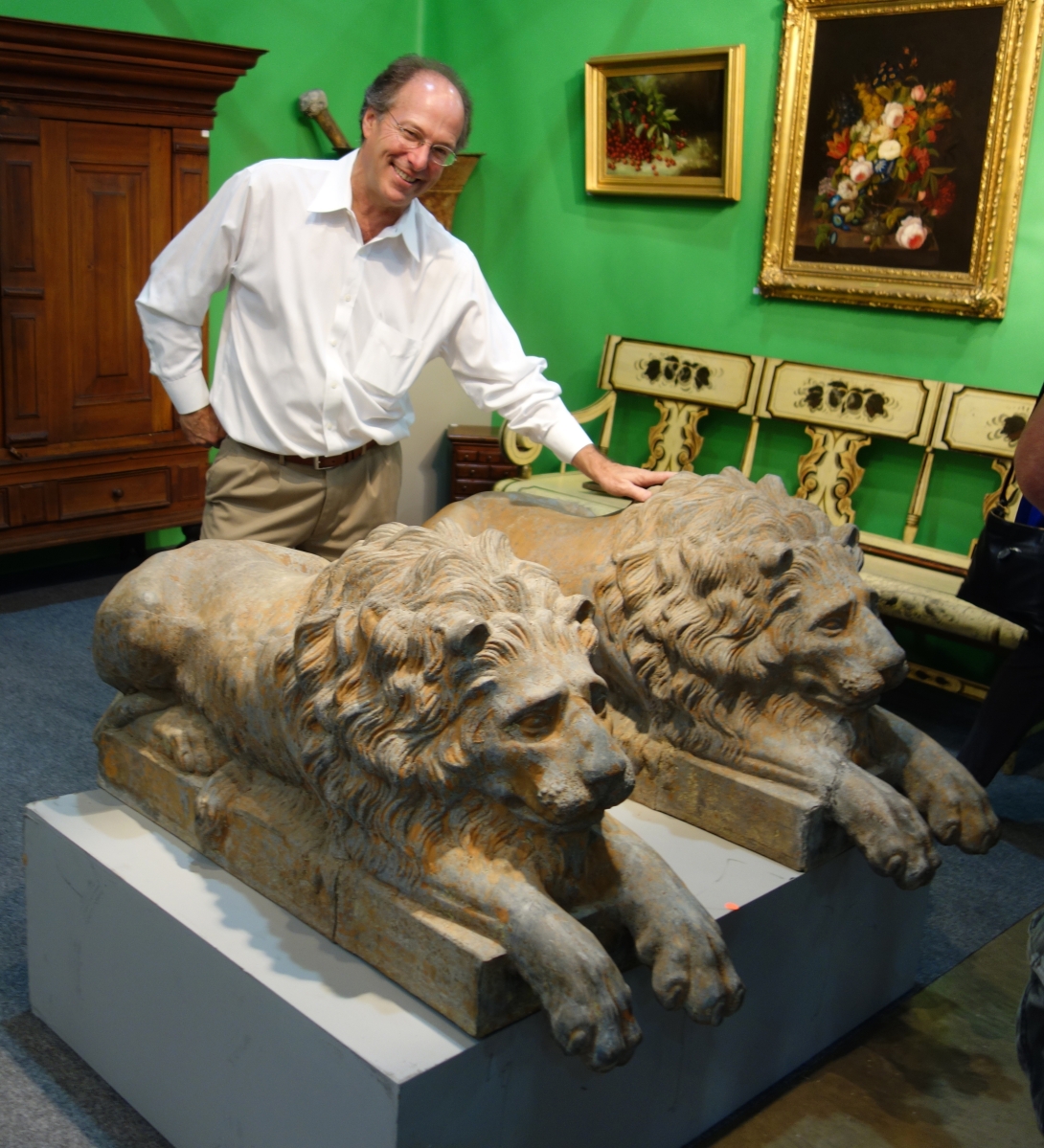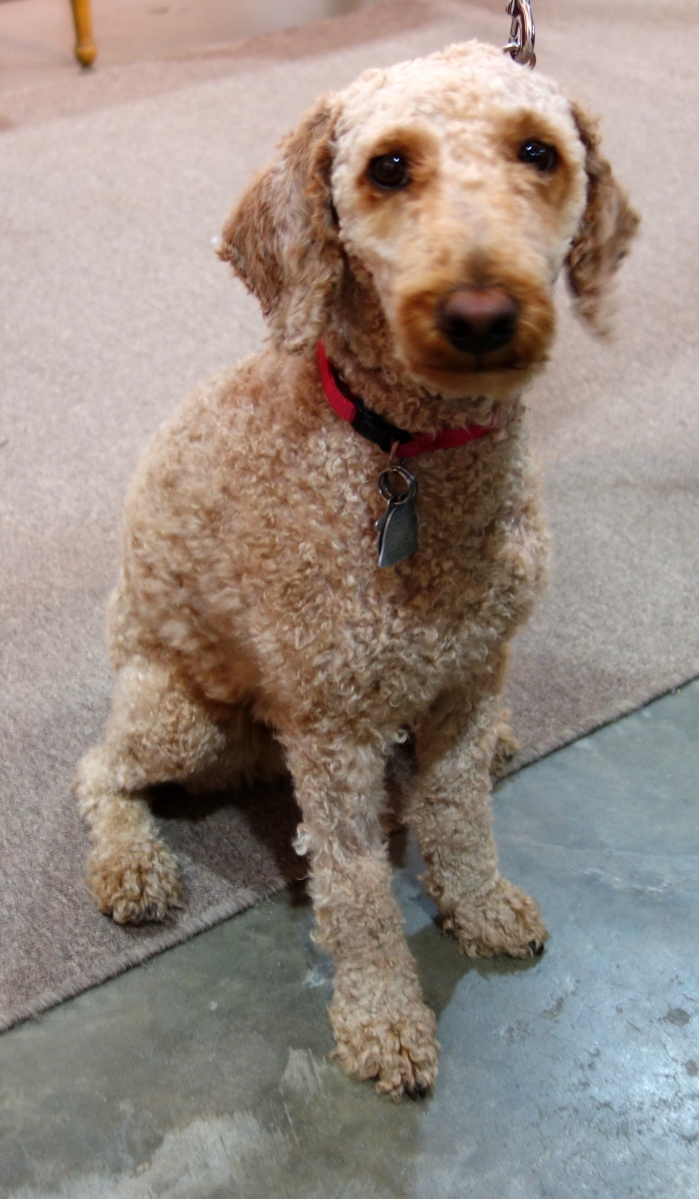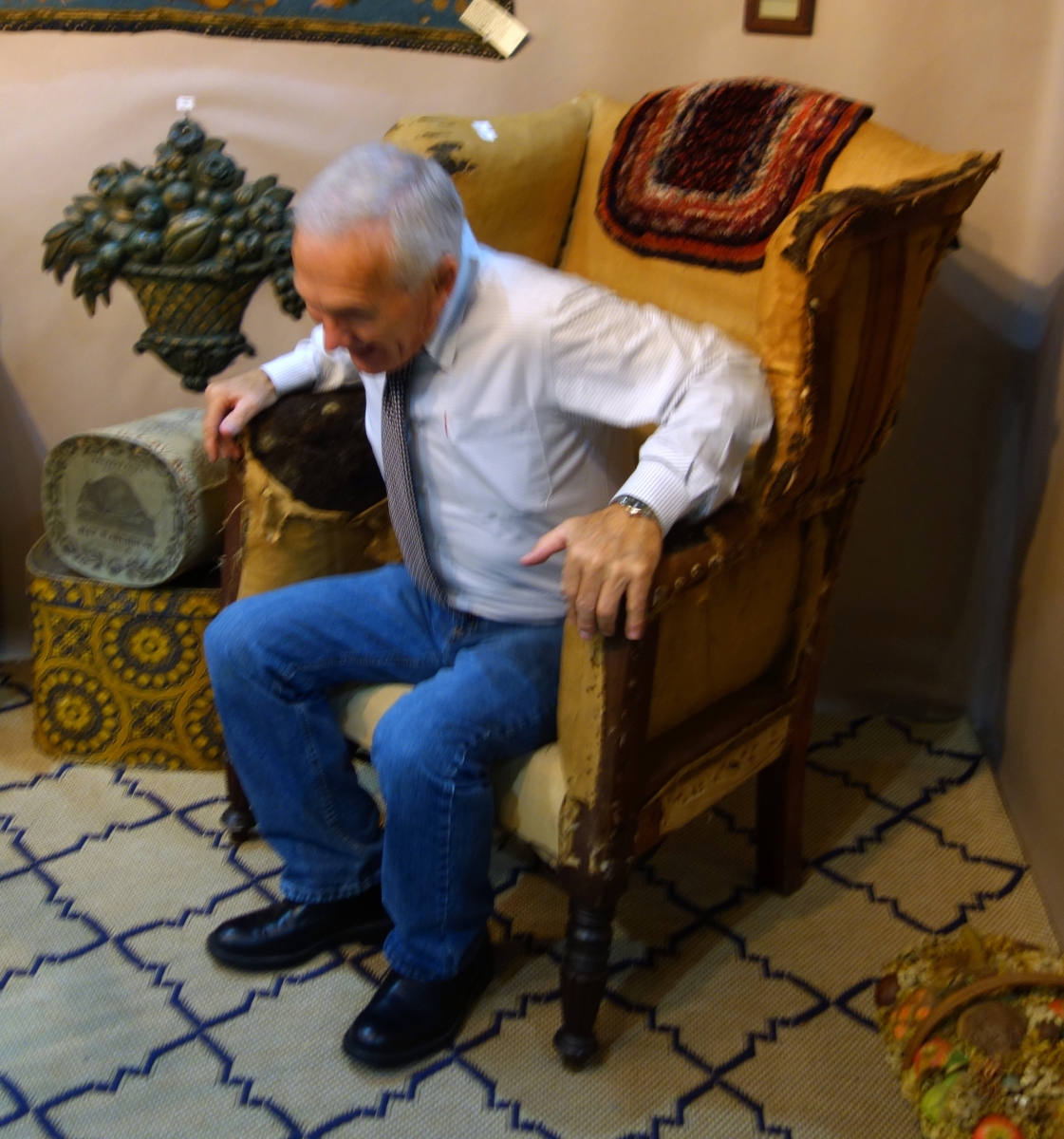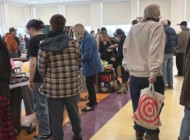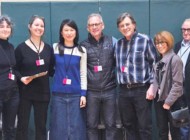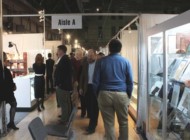Review by R. Scudder Smith and Greg Smith, Photos by R. Scudder Smith
YORK, PENN. — “I am still worn out,” Melvin “Butch” Arion, show manager, said a few days after the close of his September 23–25 167th Semi-Annual York Antiques Show. And it is easy to see why he was still tired as it is a job with many worries, but well worth it when many of the visitors take the time to express their appreciation to him. “We had a lot of people thank us for the show, some talked about the things they were going home with, and others said they had fun talking with many of the dealers,” Butch said.
Yes, it was a good-looking show, evidenced by the effort the dealers put out to present interesting things, many of them fresh to the market. Those who collect paint and Pennsylvania had to be pleased, the holidays were well represented, folk art was plentiful, ceramics and pottery filled some shelves and many so-called “fun things, such as trade signs, small carvings and toys, were available.
According to the management, Friday, opening day, the gate was excellent, with a good deal of buying. “Saturday the gate was down and I can’t think of any reason for that,” Butch said. He noted that Sunday is not a day of crowds, but “dealers tell me there are sales and it is good to stay open.”
Memorial Hall East, site for the show, holds 96 booths, which includes some exhibitors in the cafeteria area near the lunch counter.
A hooked rug with a Quaker figure in the center and dated Nov 9, 1898, hung in the booth of Douglas Wyant, Cassopolis, Mich., and nearby was a small yellow suitcase with red lettering that once contained the bag of tricks used by The Great Henly, Magician. A table with a blue tinted glass top had a frame made out of beer cans, many different and seldom-seen brands.
An early wooden and painted trade sign in the shape of a large oyster announced the firm of Sheppard Campbell, Wholesale Oysters, and was shown on the back wall by Christopher Evans Antiques, Waynesboro, Va., and a one-door cupboard retained the original blue painted surface. Among the pottery offered was a stoneware jug with an incised bird decoration and a grouping of redware plates, all slip decorated, varied in design.
Dominating the long table at the front of the booth of Holden Antiques, Sherman, Conn., and Naples, Fla., was a train weathervane cut from a piece of sheet tin depicting a locomotive, coal car, boxcar and caboose, all paint decorated. This piece, found in upstate New York, dated from the early Twentieth Century and measures 76½ inches long. A pair of Nineteenth Century portraits, artist unknown, were oil on wood panels measuring 11½ by 14½ inches sight, all original condition. An interesting selection of corkscrews included examples with both wood and bone handles.
Robert Snyder–Judy Wilson Americana & Folk Art of Mount Joy, Penn., offered a mustard and black painted round pedestal-base dining table, 48 inches in diameter, found in Connecticut, and a good-sized hooked rug with “Home Sweet Home” lettering. Shown in a glass case was a folk art model of a tugboat, Clyde, that once operated on Lake Erie and the Ohio River. This model, in the original paint, measures 21 by 10½ inches. Furniture in the booth of Bruce Rigsby Antiques, Lancaster, Ky., included an Eighteenth Century cupboard with a door top and bottom. It retained the original blue painted surface and had H hinges. Also shown was an early tavern table of New England origin.
Pat and Rich Garthoeffner of Lititz, Penn., were in their regular spot by an exit with a case for cast iron and tin toys, as well as other smalls, in addition to a large sign on the back wall for “Dance Every Saturday Nite” and a hooked rug with a red car on a light green ground on the side wall. An 1880s Ives windup locomotive in the original paint was parked on a pedestal in the booth, and on another pedestal was a circa 1900s pond boat, under full sail, with a white and black painted hull.
Jewett-Berdan of Newcastle, Maine, occupied the booth on the other side of the exit door, which was filled with folk art and paint. Against the back wall was an intricate wooden weathervane with a whirligig on top, a prop on the front and a large wooden circle at the rear to keep the vane pointing into the wind. This piece was from New Jersey and was ex Edith Halpert. A wood carved folded umbrella was paint decorated, dated 1919 and made by John W. Fox for Reverend Sylvester Fulmer. A grain box in the original blue paint, with offset drawer on the bottom, was stenciled with the name Jacob Kurtz, Lancaster Co. on the inside of the lid. “We don’t know if that is the name of the man who made the box or the owner,” Tom Jewett said.
A fireboard from a single pine board, 26 by 35 inches, circa 1835, Franklin, N.Y., with the original decoration, was set into a mantel in the booth of Axtell Antiques, Deposit, N.Y. A mother collie and her pups were depicted on a hooked rug from the Lancaster, Penn., area, circa 1890, excellent condition, and a nest of graduated burl bowls held a selection of wood carved ladles and scoops.
John H. Rogers of Elkins, N.H., had a sold tickets attached to a maple six-drawer tall chest from New England, and a slant lid desk in walnut, Pennsylvania origin, dated from the mid-Nineteenth Century. Seven shelves were crammed with wood carved butter stamps, with more filling four large wooden bowls under the bottom shelf, and there was a more than adequate supply of burl scoops for sale. Several tin candle molds were in a line, one tall example with 24 molds, another with a capacity to pour only six candles, and one with 24 molds, only shorter than the first one.
Stephen-Douglas Antiques, Rockingham, Vt., showed a stepback cupboard with one door on the lower section and shelves above, which were filled with painted tole, including a coffee pot, document boxes and tins. Five wooden book-shaped boxes made an interesting graduated stack, and a wooden trade sign was for “C.B. Maynard, Grocer” with an oval painted picture of various products. A carved wooden standing horse, with the original white painted surface, about 2 feet tall, was on the floor looking out from under a small table, and on a side wall of the booth a tall cigar store Indian, flat and good on both sides, American, circa 1870, retained the original painted surface.
A flat-carved wooden eagle with a wide wingspan, perched on a rod and in the original paint, circa 1900, looked out over the booth of DBR Antiques-Doug Ramsay, Hadley, Mass., from the back wall. A circa 1900 diorama showed a three-masted sailing ship at sea, with a lighthouse and small vessel in the background, all carved and painted against a blue sky and ocean. A Black Hawk weathervane sported a very good surface, and a black seated cat doorstop showed only slight brushes against a door.
Don and Betty Jo Heim of Jersey Shore, Penn., had a mixture of trade signs, toys and both still and mechanical banks. A sign touting Geese For Sale, black lettering on a white ground with an illustration of a single goose hung on the wall over a table with a seldom-seen roly-poly in fine condition. A 1940 Keystone Ride Um dump truck was in fine condition, as was a Buddy L yellow and red painted truck that a youngster could either ride on or be pulled. A number of mechanical banks, all in good working order, included Dark Town Battery baseball bank, Lion and Two Monkeys and Tammany.
Steven F. Still, Manheim, Penn., showed painted furniture that included a one-drawer dressing table with grain painted top and yellow legs, a pine bucket bench with two doors on the bottom in the original red, mid-Nineteenth Century, 46 inches wide and 47½ inches high, and a painted and smoke decorated tapered leg stand, circa 1830, from Maine. A pair of Hessian soldier andirons retained the original paint, and a green grasshopper weathervane was of sheet metal.
A six-board blanket chest with two panels on the front, each paint decorated with red and yellow flowers in a pot on a green ground, with more decoration on both ends, was in the booth of Samuel Forsythe, Columbus, Ohio. A watercolor on velvet still life showed fruit on a tray, including a watermelon, a cut apple, strawberries, grapes and a knife. And for those into lighting, Sam offered a selection of early Betty lamps.
In his usual place just inside the entrance to the main room Greg K. Kramer & Co., Robesonia, Penn., set up a large booth and filled it to the limits with a collection of furniture and countless objects, including pottery, iron, pictures, carvings, fabrics, etc. A four-shelf bucket bench, Pennsylvania origin, was loaded with pieces of decorated stoneware and redware, and a two corner cupboards were filled with colorful ceramics. And for those who still have plenty of display room at home, a very large wooden barber pole, red and white striped with large ball on top, awaited a buyer from the corner of the booth.
Dennis Raleigh of Wiscasset, Maine, had a selection of folk art objects in many different materials, including a tall boot trade sign, red and black painted sheet metal, and a small version of a full-bodied copper weathervane, original weathered surface, dating circa 1890. Dennis mentioned that “this is a rare size for an eagle vane, seldom seen, and this example is in excellent condition.” Among his wooden pieces was a salesman’s sample of a work sled dating from the Nineteenth Century.
Stealing most of the attention in the booth of Kelly Kinzle, New Oxford, Penn., was a very large pair of zinc reclining lions by Fiske, with their paws hanging over the front of the platforms they were resting on. The pair sold within minutes of the show opening on Friday. A wood carving of a small cigar store figure in original paint was standing on a table, and one corner of the booth was filled with a large mortar and pestle trade sign in iron with a rusted surface.
It was impossible to miss the red weathervane displayed on a tavern table in the booth of Samuel Herrup of Sheffield, Mass. This vane, a stylized automobile dating circa 1930, was of sheet metal and made in Tucson, Ariz. The tavern table, with one drawer and a two-board pine top with breadboard ends was of New England origin, circa 1780–1800. Another table offered dated from the Eighteenth Century, had a maple top and legs with pine frame, stretcher base and was from New England.
James and Nancy Glazer, Bailey Island, Maine, offered a set of six fancy side chairs, New York, circa 1810, in the original red and gold leaf decoration. This set, with turned legs and button feet, was in mint condition. Another interesting piece in the booth was an inlaid table, dated 1879, with 18 figural motifs on a round top. “This is a tilt top table and the inlay is best seen with the top vertical,” Jim said, as he altered the look of the table.
A red painted high chair with gold decoration, and the proper wear, was shown by Thomas Thompson of Pembroke, N.H., along with black painted on white trade signs for “peaches” and “apples.” A Peter Rabbit doll’s chair retained the original paint, and a wooden bed mat covered most of the back wall of the booth. As Tommy was explaining the function of the bed mat, a support on a rope bed for the feather mattress, a man walked into the booth and bought it, much to the delight of Tommy.
Hanes and Ruskin, Old Lyme, Conn., displayed an attractive pair of sack back Windsor chairs from Massachusetts, circa 1790, and also had a Connecticut tavern table with unusual turnings from the first half of the Eighteenth Century and an August Edouart American family profile made in 1839.
An early Nineteenth Century poplar and pine slant front desk in a Spanish brown paint could be found in the booth of Stiles House, Woodbury, Conn. A few pieces of old painted furniture were on show, including an Eighteenth Century Pennsylvania Chippendale walnut spice chest and a red painted Windsor table with circular top on tripod base.
Doug and Bev Norwood of The Norwoods’ Spirit of America hung up a display of pictures that covered nearly every inch of their walls with curated objects below. The Timonium, Md., dealers showed off a colorful fraktur by the Montgomery, Penn., Blowsy Angel Artist from 1791. They also had an early watercolor of the USS Water Witch, a gunboat in the US Navy that was constructed in 1851.
Bertolet House Antiques, Oley, Penn., arranged a tasteful vignette including painted furniture, stoneware and decoys. Among the furniture was a choice Lebanon County dower chest, circa 1820, in sponged paint with a diamond border.
Jim & Victoria Emele, Dublin, Penn., brought a stepback cupboard in good, early red paint from the Eighteenth Century. No cupboard can be left empty, so the dealers filled it with early American redware pitchers from top to bottom.
Queen Anne furniture was in style at the booth of Jeffrey Tillou, as the Litchfield, Conn., dealer offered a Pennsylvania tavern table in yellow pine and maple, circa 1730–50, as well as a Pennsylvania daybed of maple with rush seat and a reclining back with yoke crest, circa 1740–50. The dealer also had an early Hudson Valley, N.Y., armchair in maple, ash and rush seat, circa 1720–50.
Across the aisle, Dennis and Valerie Bakoledis, Rhinebeck, N.Y., had a prominent, diamond-shaped Nineteenth Century sign from the Tomlinson Oneida Hotel in New York with wonderful paint. In the back corner of the sign was an articulated black figure, circa 1900, that stood on a carousel calliope and the sign was attributed to the Herschell-Spillman Company.
West Pelham Antiques, Pelham, Mass., featured a lively geometric hooked rug with horses, mules and zebras, as well as a pair of mocha agateware plates by Thomas Fradley, circa 1870. In the spirit of the election, the dealer had an antique child’s armchair with elephant form sides and the name “Donald” written across the back.
In the booth of Mark and Marjorie Allen, Gilford, N.H., stood a small-sized Pennsylvania chest on chest, circa 1765, in walnut with an open bonnet top. Nearby was a large and colorful early Nineteenth Century French bride’s box with domed top hailing all the way from Normandy. The dealers also carried a beautiful Pennsylvania brace back Windsor chair from the late Eighteenth Century, which was possibly made by John Ackerly.
Berks County was seemingly everywhere in the booth of Philip H. Bradley, Downingtown, Penn., including a paint decorated lift lid chest over drawers, circa 1785, with vibrant paint. The dealer also had a tall walnut case clock with eight day movement, made in 1795 and attributed to Thomas Wildbahn of Reading, Penn.
James Price, Carlisle, Penn., carried a selection of antique American furniture, including a Queen Anne walnut dressing table with molded top on cabriolet legs ending in pad feet. The piece was made in Pennsylvania, circa 1775. Also from the dealer was a paint decorated softwood schrank with a molded cornice, fluted stiles and arch raised panel doors. The attractive cabinet was from Lancaster County, Penn., and was made in 1780.
Thomas Brown, Canonsburg, Penn., brought a quality mix of offerings, including four Massachusetts shell carved chairs of mahogany with rush seats, circa 1790. If you needed to get around in true style, he offered a big wheel bike, circa 1890, with original surface. On a wall behind sat a Walter Baum (Sellersville, Penn., 1884–1956) oil painting of an early American dirt road village scene.
By the time we had reached John Chaski, Lewes, Del., the dealer had already sold a 1780 Pennsylvania tiger maple chest on chest. The sale went to another dealer and when asked how the show was going so far, Chaski replied, “We’re off to a good start.”
Steve Smoot Antiques & Navajo Textiles, Lancaster, Penn., featured a lively display of smalls in the front of his booth, including antique Indian baskets and iron banks and toys. The dealer had a set of six Lancaster dining chairs with good paint, circa 1870.
Newsom & Berdan, Thomasville, Penn., reported a sale during the show opening of a folk art bird tree with 11 carved and decorated birds perched about from the early Twentieth Century. In the middle of their booth, the dealers showed off an open top Hudson Valley pewter cupboard from 1710–40. The piece had a scalloped top and molded plate rails with lollipop ends in yellow and white pine.
Scott Bassoff and Sandy Jacobs showed off a Windsor chair with an excellent carved saddle and original paint, probably from New York and circa 1850. Also offered was a wonderful Nineteenth Century pastel on paper of horses from the late Nan Gurley collection, as well as a Chinese export reverse painting of a woman tending to her birds from the late Eighteenth Century in original frame.
The next edition of the York Antiques Show & Sale, managed by Butch, will be February 3–5 at the same location.
For additional information, 302-875-5326 or www.theoriginalyorkantiquesshow.com.

